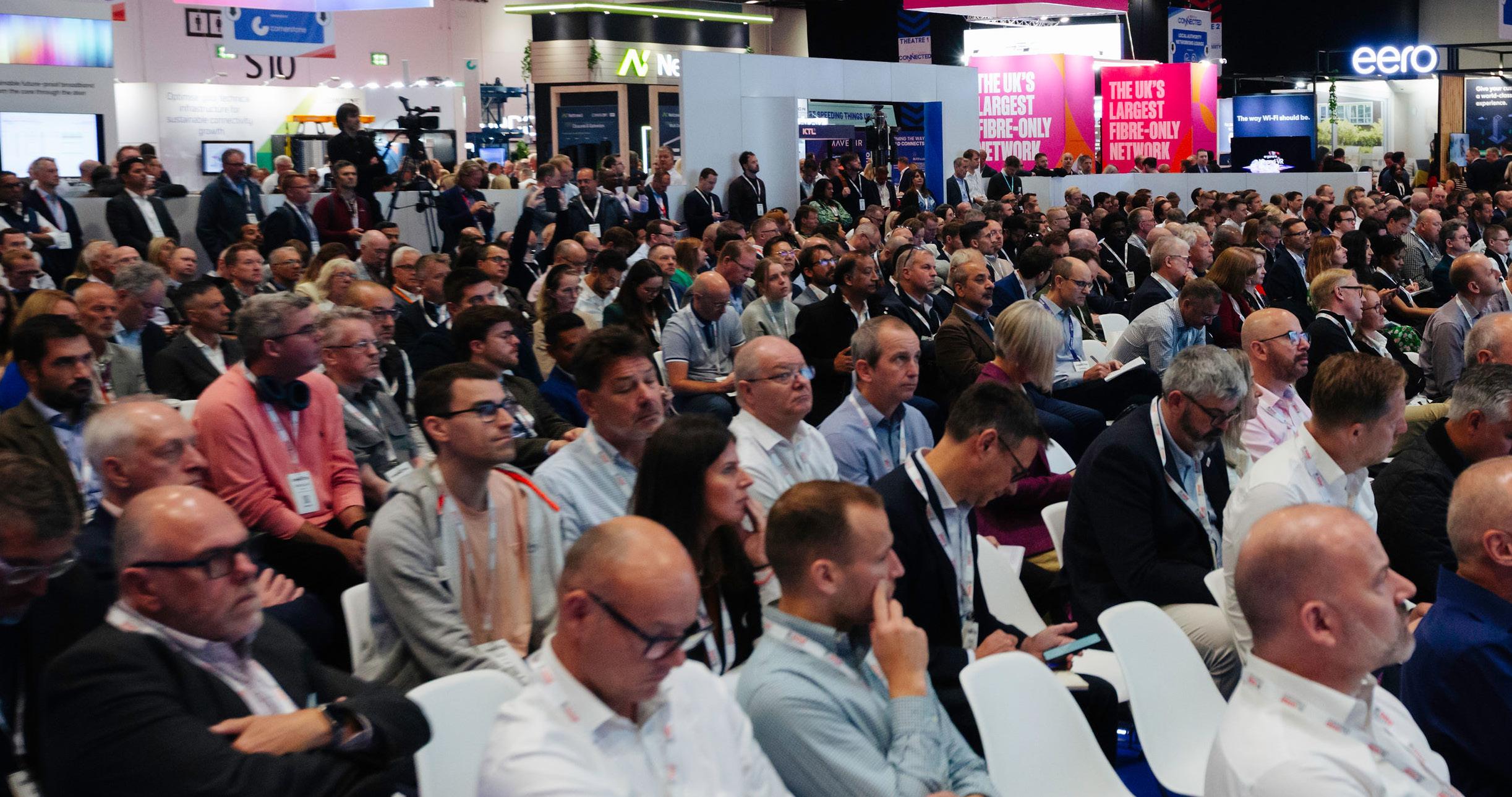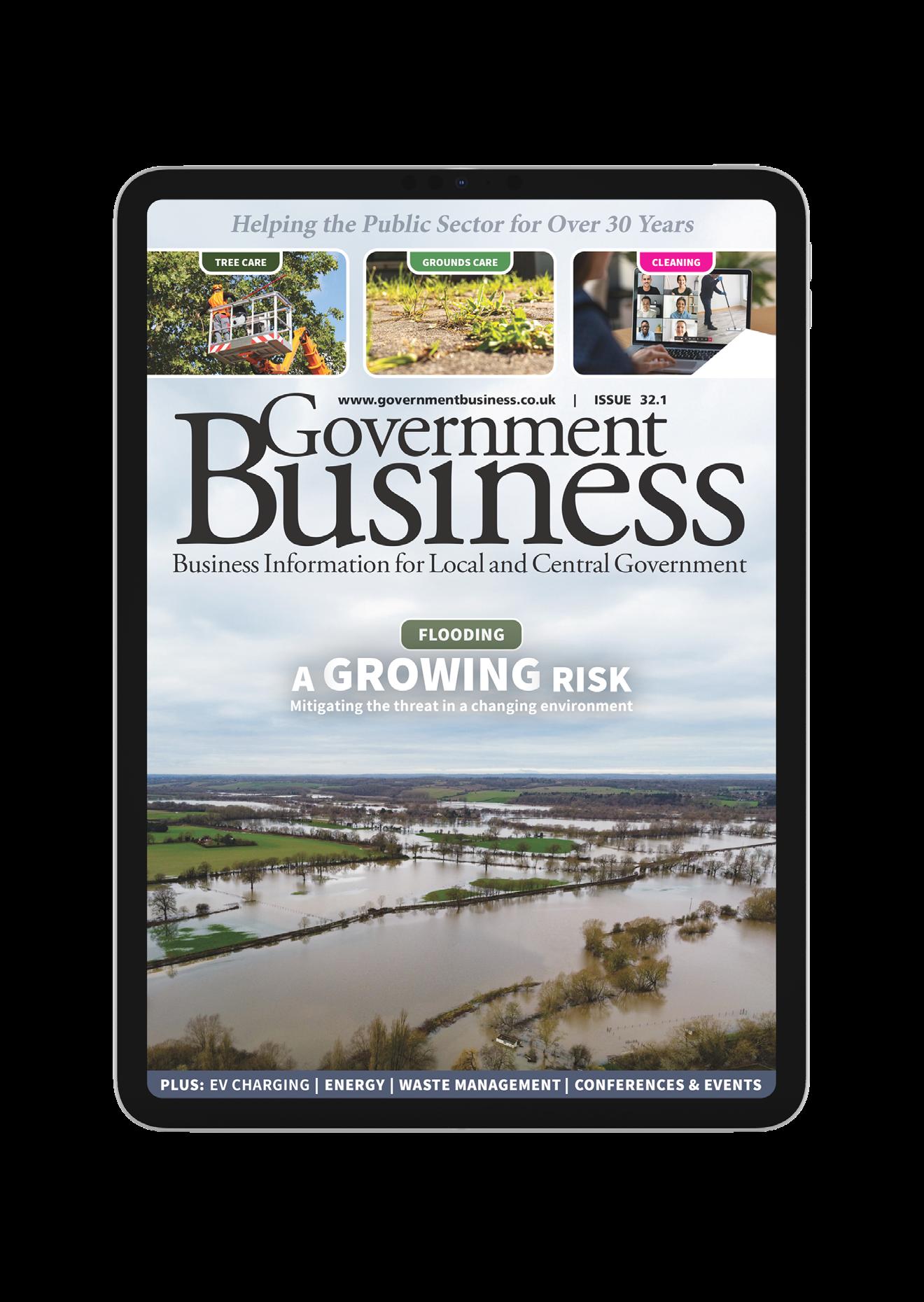









Enhance your business by unlocking the power of AI-driven information capture and management to boost efficiency, drive smarter decisions, and streamline operations—without the costly disruption of replacing existing systems. After all, the smartest transformations aren’t about starting from scratch — they’re about adding the perfect layers for a richer, more satisfying solution. It’s a piece of cake.


EDITOR
Polly Jones
EDITORIAL ASSISTANT
Meghan Shaw
PRODUCTION MANAGER & DESIGNER
Dan Kanolik
PRODUCTION DESIGNER
Sophia Mew
PRODUCTION CONTROL
Deimante Gecionyte
ADMINISTRATION
Enkelejda Lleshaj
WEB PRODUCTION
Freya Courtney
ADVERTISEMENT SALES
Steve Day
PUBLISHER
Kylie Glover
GROUP PUBLISHER
Karen Hopps
To register for your FREE Digital Subscription of GovernmentTechnology magazine, go to www.governmenttechnology.co.uk or contact Public Sector Information, 226 High Road, Loughton, Essex, IG10 1ET Tel: 020 8532 0055
PUBLISHED
SECTOR INFORMATION
226 High Rd, Loughton, Essex, IG10 1ET Tel: 020 8532 0055
Web: www.psi-media.co.uk

E V E R Y T I M E .

















Shield your laptop screens from prying eyes while experiencing best-in-class brightness and exceptional clarity.
3M™ Bright Screen Privacy Filters utilise nanolouver technology to help you deter “Visual Hackers” while enabling up to 85% light transmission for the intended user. This makes them around 25% brighter than competing privacy screens.
Contact you IT Equipment provider and have them ask about our Government and Public sector supported pricing.


http://www.3m.co.uk/privacy-protection

New AI technology that could help write the documents that are needed to discharge people from hospital could get patients home more quickly and free up beds on busy wards.
It is hoped the technology will help cut waiting lists by giving frontline staff time to handle other tasks.
The technology is currently being developed at Chelsea and Westminster NHS Trust, and is one of many projects to receive backing from the Prime Minister as part of the AI Exemplars programme.
Using a large language model, the tool could help doctors to draft discharge documents faster by extracting key details from medical records, such as diagnoses and test results. After review from a medical expert responsible for the patient, these documents are then used to discharge a patient from a ward and refer them to other care services that may be needed.
Speaking on a visit to Chelsea and Westminster Hospital, technology secretary Peter Kyle said: “This is exactly the kind of change we need: AI being used to give doctors, probation officers and other key workers more time to focus on delivering better outcomes and speeding up vital services.
“This government inherited a public sector decimated by years of under-investment and is crying out for reform. These AI Exemplars show the best ways in which we’re using tech to build a smarter, more efficient state.
“When we get this right across government, we’re talking about unlocking £45 billion in productivity gains – delivering our Plan for Change and investing in growth not bureaucracy.”...


£9.5 million for councils to help get people online
The government has announced £9.5 million of funding for local charities and councils to help get people online.
The Digital Inclusion Innovation Fund is designed to boost grassroots efforts to help the 1.6 million people in the UK who can’t access to online world.
The investment will support ways of tackling digital exclusion, which could include putting on workshops to familiarise people with tech or schemes donating devices like phones and laptops to the digitally excluded.
Research suggests that 7.9 million adults across the UK lack basic digital skills, while 1.6 million people live offline altogether.
Local government, charities and research organisations in England can apply for funding worth £25,000 to £500,000. The devolved governments in Scotland, Wales and Northern Ireland will determine their own arrangements.
UK telecoms minister Sir Chris Bryant said:
“It is unacceptable that in 2025, millions of people across the UK simply can’t access the vast opportunities that technology and the online world offers. Digital inclusion is an essential for modern life and work, not just something that’s nice to have, and it forms a critical part of our Plan for Change.
“Making technology widely accessible could be the thing that means a sick patient can speak to a GP remotely, or that helps a young person successfully apply for a job. Through this funding we’re moving further to empower local leaders and groups nationwide, who are already working tirelessly to get their communities connected and change countless lives for the better.”...














Science Minister Lord Vallance has called on businesses and researchers to develop technology that could cut energy costs in the long term.
£4 million has been allocated for the first year of a five-year challenge that will support researchers to come up with solutions that help shift electricity demand in evenings and weekends by two gigawatts.
This could potentially cut energy costs in the long term for the consumer, boost energy security and further reduce reliance on fossil fuels.
Research will deliver better forecasting and help manage and shift demand at busy times by the equivalent to the amount used by one and a half million homes.
Examples could include getting AI to predict how much energy we’ll use days ahead of time or automatically heating or cooling buildings when clean energy is most available and cheapest.
The Clean Energy: 2GW Peak Time Flexibility challenge is the first of 5 to be announced as part of the R&D Missions Accelerator Programme.
The project will be led by UK Research and Innovation (UKRI) in collaboration with the Department for Energy Security and Net Zero (DESNZ).
Minister for climate Kerry McCarthy said: “We are working to build a more flexible electricity...


The government has announced £426,000 of new funding for the Tackling Organised Exploitation (TOEX) Programme.
The funding will be used to extend access to its Capabilities Environment, a suite of investigative apps and tools, to every police force in England and Wales. 13 currently already have access.
The TOEX Capabilities Environment expansion supports the first phase of Operation Beaconport, the new national policing operation announced following Baroness Casey’s National Audit on Groupbased Child Sexual Exploitation and Abuse.
Police will now be able to access the tools to assist with any criminal investigation in their force. So far, the 13 forces which have access to them have used them 12,500 times. This has saved over £20 million and 16,000 investigator hours.
This includes access to the Data Analysis and Review Tool, which analyses large amounts of digital data to identify communications patterns and relationships between suspects; and TOEX Translate, a tool for the bulk translation of foreign language text from seized mobile devices.
Jess Phillips, minister for safeguarding and violence against women and girls, said: “The sexual exploitation of children by grooming gangs is one of the most horrific crimes and we must punish perpetrators, provide justice for victims and survivors, and protect today’s children from harm...



Say hello to the future of safer and healthier structures for those who live, work and learn in them.


An online application delivering:
An online application delivering:
✓ Instant Access
✓ Instant Access
✓ Detailed & user-friendly information
✓ Detailed & user-friendly information
✓ Proactive solutions
✓ Proactive solutions
✓ Reports with supporting images
✓ Reports with supporting images
✓ Timely submissions
✓ Timely submissions
✓ Embedded SMART Technology
✓ Embedded SMART Technology
✓ Enduring Regs and Act compliance
✓ Enduring Regs and Act compliance
✓ Awaabs Law fulfilment
✓ Awaabs Law fulfilment
✓ Peace of mind
✓ Peace of mind
✓ Cost effective outcomes
✓ Cost effective outcomes
Tel: 0344 846 0955
Tel: 0344 846 0955 enquiries@ cornerstone-ltd.co.uk
www.propertyhealth.co.uk



The Cyber Assessment Framework (CAF), provided by the National Cyber Security Centre (NCSC), has been updated in response to growing threats.
The tool helps organisations improve their cyber security and resilience, so they can protect critical services from cyber threats.
The CAF is mainly designed for CNI organisations operating essential services in areas including energy, healthcare, transport, digital infrastructure and government sectors, helping them to meet legal and regulatory requirements such as the NIS Regulations. It provides a comprehensive framework for assessing how well an organisation is meeting expected security and resilience outcomes, identified as appropriate in relation to a particular level of threat.
The last version was published in April 2024 and its adoption has continued to spread. It’s now used by nearly all UK cyber regulators and GovAssure, the cyber security assurance scheme for assessing the UK’s critical national infrastructure (CNI).
Meanwhile, the cyber threat to the UK’s CNI has continued to increase.
The CAF has been updated to ensure it remains relevant and ensure that organisations’ defences are up to date....


The government has invested £100 million in border security.
The investment will pay for up to 300 extra National Crime Agency officers (NCA), stateof-the art detection technology and new equipment.
The Border Security Command, the NCA, the police and other law enforcement agency partners will see a cash injection to strengthen investigations targeting smuggling kingpins and disrupt their operations across Europe, the Middle East, Africa and beyond.
The money will boost existing law enforcement operations and allow more intelligence to be gathered on organised immigration crime gang members, support upstream capacity building, and purchase sophisticated technology and equipment to strengthen UK border security.
National Crime Agency Director General of Operations Rob Jones said: “The NCA focuses on making the biggest impact on organised crime groups behind these lethal crossings.
“We currently have 91 investigations ongoing into the most dangerous people smuggling networks impacting the UK, and are working with partners at home and abroad to target, disrupt and dismantle them.
“This additional funding will help boost our capacity and capability, enabling us to target more offenders.”







Indoor GPS

FR3120130A1, US12066558B2
Indoor GPS
Indoor GPS
Indoor GPS
FR3120130A1, US12066558B2
FR3120130A1, US12066558B2


Give off line

Give off line
Quantum
Quantum safe Secure internet
Quantum safe Secure internet
Random hash US20200351100A1, FR3092923B1, US11914754B2, US20240111717A1,US11956367B2
Offline transactionss: FR3080934B1, US10643198B2, CN110443595B
Quantum safe Secure internet
Random hash US20200351100A1, FR3092923B1, US11914754B2, US20240111717A1,US11956367B2
Random hash US20200351100A1, FR3092923B1, US11914754B2, US20240111717A1,US11956367B2
Quantum safe communication
Offline transactionss: FR3080934B1, US10643198B2, CN110443595B
Quantum safe communication
Entangled photon communication: FR3125658 , US11843419B2, FR3125659B1, FR3125658A1, EP4374511A1
Quantum safe communication
Entangled photon communication: FR3125658 , US11843419B2, FR3125659B1, FR3125658A1, EP4374511A1
Entangled photon communication: FR3125658 , US11843419B2, FR3125659B1, FR3125658A1, EP4374511A1
Entangled photon communication: FR3125658 , US11843419B2, FR3125659B1, FR3125658A1, EP4374511A1
Quantum safe Secure internet
Random hash US20200351100A1, FR3092923B1, US11914754B2, US20240111717A1,US11956367B2
www.carrouseldigital.com
offline/online secured ID : FR3104357B1 US20200351100A1 , FR3092923B1 , US11956367B2 Start-up
www.carrouseldigital.com
offline/online secured ID : FR3104357B1 , US20200351100A1 , FR3092923B1 , US11956367B2 ,



c/o MarbeufConseil et Recherche 42 rue Maubeuge75009 Paris, France
FR3120130A1, US12066558B2 www.carrouseldigital.com
www.carrouseldigital.com
c/o MarbeufConseil et Recherche 42 rue Maubeuge75009 Paris, France
c/o MarbeufConseil et Recherche
66 avenue des Champs Elysées 75008 Paris , France








The police are set to rollout AI to catch criminals by 2030, according to a new announcement by technology secretary Peter Kyle.
Top scientists are developing a detailed real time and interaction crime map that spans across England and Wales to detect, track and predict where devastating knife crime is likely to occur, and spot early warning signs of anti-social behaviour before it escalates.
Advanced AI will bring together data shared between police, councils, and social services, including criminal records, previous incident locations and behavioural patterns of known offenders.
The Concentrations of Crime Data Challenge brings together teams from business, universities, and beyond to develop the solution to be operational across England and Wales by 2030, as part of the government’s £500 million R&D Missions Accelerator Programme.
As part of an initial £4 million government investment, teams will deliver the initial prototypes to develop the mapping system by April 2026, which will also support the Safer Street Mission, which aims to halve knife crime and violence against women and girls (VAWG) within a decade.
Peter Kyle, science and technology secretary, said: “Cutting-edge technology like AI can improve our lives in so many ways, including in keeping us safe, which is why we’re putting it to work for victims over vandals, the law-abiding majority over the lawbreakers.
“Our police officers are at their best when they join up to prevent crime rather than react to it, ...

Jade Leung appointed PM’s AI adviser:
READ MORE
Companies invited to work with government on agentic AI: READ MORE
Funding for innovative projects across Manchester: READ MORE
AI to be used to prevent prison violence:
READ MORE
Thousands use prescription tracker in NHS
App: READ MORE
Cardiff to receive £30m for R&D: READ MORE

New data from Confused.com has revealed that over 50,000 council-owned public electric vehicle (EV) chargers are expected to be spread across the UK over the next two years. There are currently 28,734 council-owned public chargers, with Confused.com predicting that an additional 24,687 chargers are expected to be installed by 2027.
According to the Society of Motoring Manufacturers (SMMT), there is currently one council-owned public charger per 36 EV drivers in the UK.
Although access is set to improve, EV drivers also seem to face bigger issues. Almost one in two (45 per cent) experience issues like long wait times or chargers being occupied, while 38 per cent have dealt with slow charging speeds.
Others report difficulties with payment systems (35 per cent) and being booked by non-EV vehicles or cars not charging in bays (31 per cent).
This research, carried out by OnePoll between 24th and 25th June 2025, used a sample of 2,000 UK drivers, and serves to inform consumers whether or not they should purchase an electric car.


34B2U3600C B-Line
34” | 3440 x 1440
WQHD Office Monitor





From security to connectivity to multitasking Philips have you covered with their ultrawide monitor that does it all
In an era of tightening budgets and increasing digital demands, public sector organisations face the challenge of modernising their IT infrastructure whilst maintaining fiscal responsibility. The Philips 34B2U3600C curved business monitor presents a compelling solution that addresses both performance requirements and cost considerations for government departments seeking to enhance.
This 34-inch curved WQHD monitor delivers exceptional value through its comprehensive feature set. The 3440×1440 resolution provides 34per cent more screen real estate than tra ditional displays, enabling civil servants to manage multiple applications simultaneously— from complex spreadsheets and database interfaces to video conferencing and document editing—without the expense of dual-monitor setups.
The monitor’s Smart KVM technology proves beneficial in environments where security protocols often require separate systems for different classification levels. Users can seamlessly switch between multiple computers using a simple three-key combination, eliminating the need for additional keyboards and mice whilst maintaining secure separation of systems. This feature significantly reduces desk clutter and improves operational efficiency in space-constrained government offices.
Connectivity remains paramount in today’s hybrid working environment. The 34B2U3600C’s USB-C docking capability with RJ45 ethernet integration addresses the increasing demand for flexible workspace solutions. Staff can connect laptops with a single USB-C cable, accessing network connectivity, high-resolution display output (thanks to USB-C DisplayPort Alt mode), and device charging (up to 90 W USB-C Power Delivery) simultaneously. This proves especially handy for hot-desking arrangements and temporary workspace deployments common in modern facilities.
The monitor’s commitment to user wellbeing aligns with public sector duty of care obligations. The TÜV Rheinland Eyesafe certification ensures
reduced blue light exposure, whilst Flicker-Free technology minimises eye strain during extended usage periods. These features contribute to improved staff satisfaction and reduced occupational health concerns—important considerations for HR departments managing large workforces.
From a sustainability perspective, the 34B2U3600C supports environmental objectives through its Energy Star certification and 85 per cent post-consumer recycled plastic content. The mercury-free, PVC/BFR-free design aligns with government procurement guidelines emphasising environmental responsibility.
The monitor’s MultiView technology enables Picture-in-Picture and Picture-by-Picture modes, allowing users to monitor multiple data streams simultaneously—particularly valuable for emergency services coordination centres, traffic management systems, and security operations requiring constant vigilance across various information sources.
Built-in stereo speakers eliminate the need for additional audio equipment, whilst the comprehensive connectivity options— including HDMI 2.0, DisplayPort 1.4, and USB 3.2 hub functionality—ensure compatibility with the existing government IT infrastructure.
For public sector organisations seeking to balance enhanced productivity with budget constraints, the Philips 34B2U3600C represents a strategic investment that delivers immediate operational benefits whilst supporting long-term sustainability goals and workforce wellbeing initiatives. M
FURTHER INFORMATION
Read more here.





As AI continues to dominate headlines and boardroom agendas, techUK’s latest AI Campaign Week set out to separate substance from hype. Usman Ikhlaq, programme manager for Artificial Intelligence at techUK, reflects on how UK industry leaders are tackling trust, infrastructure, and talent to scale AI responsibly and what it really means to lead in a fast-evolving global landscape
Artificial Intelligence has dominated the headlines in recent years – from the rise of generative AI platforms like ChatGPT to questions around safety and the implications of AI, there has not been a day where this technology has not been talked about in the media, business planning, and even in day-to-day conversations. But, and perhaps because of this proliferation of talks around AI, it is sometimes difficult to understand what AI actually is achieving, to the point that some of the debate is shifting and some are asking themselves “is AI actually promising or is it just fluff?”.
In May, techUK ran its most ambitious AI Campaign Week yet, bringing together industry leaders, research institutes, and technology
experts under the theme of seizing the AI opportunity to help make sense of what AI can actually do for people, society, economy, and the planet. Our aim was to showcase the UK’s position as a global AI powerhouse while addressing the critical challenges and opportunities that lie ahead in our nation’s AI journey.
With AI poised to boost UK GDP by an estimated £550 billion by 2035, the urgency of widespread AI adoption has never been clearer. Our AI Campaign Week shone a spotlight on visionary ideas and expertise from across out membership to propel the AI sector forward through informed discussion and collaborative ambition. E


Exceptional customer experience (CX) is more than a commercial goal it’s a public service TTEC Digital blends cuttingedge technology with human empathy to help public sector organisations deliver seamless, personalised, and impactful interactions
With deep expertise across platforms like Microsoft, AWS, Google, Genesys, NICE, Salesforce, and ServiceNow, we empower agencies, housing associations, and councils to modernise citizen engagement and improve service delivery
We proudly support some of the UK’s largest public sector organisations, transforming legacy systems into agile, cloudbased ecosystems for smarter, faster, and more inclusive services
As global delivery leaders in CX and AI, we harnesses the power of Artificial Intelligence to help anticipate citizen needs, automate routine tasks, and provide a more empathic, smarter and personalised services
CX Strategy & Design
Crafting citizen-centric journeys that reflect the values and priorities of public service
AI & Automation
Enhancing responsiveness and reducing cost-to-serve

Digital Transformation & Integration
Modernising infrastructure and connecting systems to enable scalable, omnichannel experiences
Data & Analytics
Unlocking insights to improve outcomes and operational efficiency




Throughout the campaign week, it has clearly emerged that the UK has a huge breadth of AI expertise – not that it’s surprising. Companies like Holistic AI and KPMG contributed their expertise on how to implement trustworthy AI frameworks, demonstrating that building trust is a strategic imperative, not just a technical one. Holistic AI has pioneered a risk-based approach to AI governance, using a platform to continuously monitor systems for potential bias, robustness issues, and transparency gaps throughout the entire AI lifecycle. Similarly, KPMG has championed a principlesbased framework for responsible AI, guiding businesses to design, build, and deploy AI solutions with a clear focus on accountability, fairness, and explainability. Together, these approaches illustrate how organisations can move beyond theoretical ethical principles to establish practical governance and monitoring systems that build stakeholder confidence and enable the safe, scalable adoption of AI.
The UK currently holds the position of having the third-largest AI sector globally, a testament to its robust research institutions, innovative start-ups and scale-ups, and more established players. However, maintaining this leadership requires more than just current capabilities – it demands a forward-thinking approach to research, development, and deployment.

The UK can maintain its AI leadership by leveraging its unique strengths
That is why we wanted to ask our members to explore what it truly means to be a leader in AI.
Industry experts from across the technology spectrum contributed to these discussions, with established players like Kyndryl and Atkins Realis sharing insights alongside innovative SMEs such as Teraflow, Puritan AI, and emerging AI specialists.
To truly lead in AI, the UK must focus on three critical areas: fostering world-class research and development capabilities, creating an enabling regulatory environment that balances innovation with responsible deployment, and building strategic partnerships between academia, industry, and government. This means investing in cutting-edge research facilities, supporting AI talent development from universities through to industry, and establishing clear frameworks that give businesses confidence to innovate while protecting citizens and maintaining ethical standards.
The UK can maintain its AI leadership by leveraging its unique strengths: world-class universities producing cutting-edge research, a robust financial services sector driving AI adoption, and a regulatory approach that balances innovation with responsibility. Our competitive advantage lies in creating an ecosystem where established corporations can collaborate with agile start-ups, where academic research translates rapidly into commercial applications, and where government policy supports both technological advancement and ethical deployment.
Perhaps the most critical challenge facing organisations today is moving AI initiatives from promising pilot projects to full-scale deployment.
Through our engagement with industry, including educational technology leaders like JISC and innovative AI platforms such as UBDS and Autogen, it’s emerged that data readiness, stakeholder alignment, and integration challenges are factors that often determine whether AI projects succeed or fail. For example, poor data quality can derail even the most promising initiatives – we’ve seen E

At Digital Data Consultancy Ltd, we specialise in helping public sector organisations harness the power of data and technology to deliver better outcomes for citizens.
• Secure Cloud-Based Data Management Solutions with Full Compliance
Our Public Sector Expertise Includes: We understand the unique challenges of government digital transformation — and we’re committed to delivering transparent, efficient, and future-proof solutions.
• Data Integration Across Legacy and Modern Systems
• AI ML based Business Intelligence for Policy & Operational Insight
• Microsoft Dynamics 365 for Citizen & Case Management


According to the current trend, almost all tech consultancies and systems integrators will promise the automation of existing processes using AI tools, providing faster, realtime, and valuable business insights from data, leveraging machine learning (ML) technology.
While the speed of development and application of AI, ML, LLM, and NLP technology in various domains have accelerated in the last one year, with more efficient tools and functionalities being invented, we believe the caveat lies not in questioning the
efficacy of the technology or the tools being used, but the question of: “What and where should AI tools and machine learning techniques be used?” Before AI and/or ML is enabled in critical and vulnerable areas, especially in sectors such as healthcare and pharmaceuticals, the particular industry should be mindful of the impact of incorrect output or outcomes suggested by such AI technologies.
Individuals and organisations should consider the ethical and legal implications of deploying AI.
Organisations should be mindful of data security and data privacy regulations, ensure that the use of AI and ML is aligned with the organisation’s values, be cognisant of AI and ML’s potential misuse, and be aware of the possible harmful consequences arising from biased or inaccurate data. M
https://tinyurl.com/dyzuyu7a

continue to increase, we must address head-on how we can face this challenge
F organisations invest significantly in AI models only to discover their underlying data infrastructure couldn’t support reliable, consistent outputs at scale, forcing them to abandon deployment plans.
These factors also continue to shape the development of AI. As the conversations shifts from large language models and generative AI, we are now seeing new transformative technologies that are reshaping the AI landscape, including agentic AI systems that can operate with greater autonomy, small language models that offer efficiency benefits, and industrial AI applications that are revolutionising manufacturing and production processes. These emerging technologies represent the next frontier of AI adoption, moving beyond traditional applications to more sophisticated and autonomous systems.
Building trust through AI assurance Trust remains the cornerstone of successful AI adoption. This is a theme that resonates strongly with both industry practitioners and policymakers, reflecting growing awareness that public and private sector confidence in AI systems is essential for widespread adoption.
We wanted to explore practical approaches to AI assurance, including model testing and validation procedures, comprehensive auditing frameworks, system cards that provide transparency about AI capabilities and limitations, and red teaming exercises that stress-test systems against potential risks and failures.
Holistic AI demonstrates how comprehensive model testing puts trust at the centre of their approach - they implement rigorous validation procedures that test AI systems across multiple scenarios and edge cases before deployment, ensuring consistent performance and identifying potential bias or failure points. Similarly, GSK’s approach to AI governance in heavily regulated healthcare environments shows how systematic auditing frameworks can build stakeholder confidence by providing clear documentation of AI decision-making processes

and regular assessment of model performance against real-world outcomes.
Industry contributors shared best practices for implementing trustworthy AI frameworks, demonstrating how organisations can move beyond theoretical ethical principles to practical governance and monitoring systems. These approaches enable companies to deploy AI with confidence while maintaining accountability to stakeholders and society.
However, none of what I have touched on in this article so far can be realised without a robust infrastructure supporting AI’s development and deployment.
As computational demands of modern AI systems continue to increase, we must address head-on how we can face this challenge. Major infrastructure provider Snowflake suggested the UK can build sustainable, scalable data infrastructure that supports both national AI initiatives and regional innovation hubs. British AI companies such as Braidr also showcased innovative approaches to AI-powered infrastructure solutions, while cloud and enterprise software specialists like Zoho UK demonstrated how companies of all sizes can access enterprise-grade AI capabilities.
The role of various stakeholders – from established data platform providers to innovative startups developing next-generation AI infrastructure solutions – was examined in E
Focus on Damp and Mould for Housing Associations
Host Dr. Hector Altamirano, Associate Professor at UCL and Academic Director for The UK Centre for Moisture in Buildings is joined by guests from the Chartered Institute of Housing, BSRIA, Greatwell Homes housing association and solutions provider Cornerstone.
Join this informative session to gain practical solutions including how AI can help tackle damp and mould in social housing.



10.30am ∙ Thursday 18th September
Live online ∙ Registration free to Local and Central Government
Sponsored by

F detail. This ecosystem approach demonstrated how both multinational corporations and agile SMEs contribute essential components to the UK’s AI infrastructure landscape.
Just like how infrastructure plays a key role in the development and deployment of AI, so does human capital.
The UK is grappling with a digital skills gap. This was real before the AI boom, but it is particularly felt now as this technology could promise incredible benefits to the UK as a whole – but won’t be able to deliver if we don’t have skilled people in place.
Our members are in agreement that the talent challenge spans the entire educational spectrum, from primary education through lifelong learning.
The campaign highlighted the importance of collaboration between industry and academia in developing relevant curricula and training programmes, with contributions from both major professional services firms and innovative skills development organisations. The EY Foundation shared their extensive AI education initiatives and youth development programmes, while specialist companies like Resolutiion and TechSkills (the skills body for tech in the UK and the accreditation body for Tech Industry Gold) demonstrated innovative approaches to AI skills development tailored for specific industry needs.
Particular attention was paid to creating inclusive AI career pathways that encourage diverse participation in the field. This focus on inclusivity reflects recognition that AI’s societal benefits can only be fully realised
The promise of AI translates into tangible benefits for businesses, public services, and society as a whole
when its development and deployment involve perspectives from across the population.
Through our AI campaign week we wanted to do more than just present a series of discussions – we wanted to create a catalyst for ongoing action. The themes explored during the week continue to inform techUK’s year-round activities, including policy development, industry events, and member collaboration initiatives.
As the UK continues to navigate the opportunities and challenges presented by AI technology, initiatives like this campaign week prove essential for maintaining momentum and ensuring that the promise of AI translates into tangible benefits for businesses, public services, and society as a whole.
The £550 billion GDP boost that AI could deliver by 2035 is not merely a projection – it represents a collective commitment to excellence in AI development, adoption, and governance. Through continued collaboration and focused action on the themes explored during our AI Campaign Week, the UK is well-positioned to seize this AI opportunity and continue leading in the global AI revolution. M
FURTHER INFORMATION
Read our full AI Campaign Week content here.



We are Databricks strategy and implementation experts; we re-engineer our client’s core business processes to accelerate value from Databricks and build intelligent, automated enterprises that leverage the power of AI. With strong public sector transport knowledge and experience having worked with Transport for Greater Manchester since 2019, we work collaboratively with our clients to improve business performance and create long-lasting value.
Find out more
Check out our other TfGM case studies here.
Deploying the UK’s largest light rail network, or the first public bus network, did not happen by accident. It happened with data.
Smart transport needs smart data. Since 2019, the data and AI consultancy Manuka has been helping Transport for Greater Manchester (TfGM) build the data platform that underpins the Bee Network—Greater Manchester’s vision for a fully integrated, London-style transport system.
What started as a tram-focused data warehouse is now a multi-modal, missioncritical analytics platform. It spans trams, buses, ticketing, contactless payments, inspections and enforcement, mobile app data, pay-as-you-go, performance reporting, finance, and more.
This evolution didn’t happen by accident. It was underpinned by strategic planning, pragmatic delivery, and a commitment to responsible innovation. Manuka specialises in helping public sector organisations turn ambition into action, through tailored data and AI strategies, roadmaps, and operating models. For TfGM, that meant not just building data pipelines but designing a future-proofed platform—governed, secure, and ready for growth.
The real test came in September 2023, as Greater Manchester became the first UK cityregion to bring buses back under local control since 1985. With over 15 million bus journeys each month, the Bee Network’s expansion demanded scale, resilience, and precision. Manuka’s team worked closely with TfGM to integrate dozens of data sources, consolidate over 80 pipelines, and scale the warehouse to four times its original capacity—all without a single unplanned high-priority incident.
The outcomes speak for themselves. Data is now refreshed daily and used by over 300
licensed users across Tableau and Snowflake to make operational and strategic decisions. Tram usage is up 30 per cent since the pandemic. Bus and tram data are now joined up in one place. Tap-and-go has also been extended across combined bus and tram journeys, enabling better services, faster insights, and an enhanced passenger experience.
Alongside technical delivery, Manuka supported TfGM with a governance strategy covering data quality, privacy, and PII. They also helped embed a culture of responsible AI and analytics. The system is now ready to incorporate train data, support cycle hire, and drive further innovation.
In a sector where legacy systems and fragmented data often slow progress, this partnership shows what’s possible with the right strategy and execution. Manuka’s role is part architect, part engineer, and part long-term partner. This includes designing Data and AI Centres of Excellence, embedding innovation, and helping public bodies deliver bold transport and digital transformation goals.
Better data means better journeys. In Greater Manchester, the journey to smarter, more joined-up public transport is already well underway.




West Midlands Police has invested in new data analysis techniques to help tackle serious violent crime and reduce the cost of crime. Using the latest geospatial tools from Esri UK the force has gained a more accurate understanding of violent crime hotspots, down to street level and individual
property, enabling more targeted policing. The project is part of the Hot Spot Action Programme funded by the Home Office. Results in the last 12 months include reducing knife crime by 16 per cent, making 812 arrests and seizing over 500 weapons. The cost of crime to society has also been reduced by £13 million. These are the latest milestones in West Midlands Police’s move to combine its Problem Oriented Policing (POP) training with the latest geospatial analysis techniques to tackle knife crime.
Project Guardian lead at West Midlands Police, detective chief inspector (DCI) John Askew, said: “Applying new analysis techniques is critical in discovering robust methods to combat serious violent crime. Having access to the most sophisticated software means our analysis is more accurate and quicker to achieve. Our patrols now act on intelligence from Esri tools and focus their attention on the right places and help reduce knife crime.” M


Derby City Council has launched the UK’s most extensive public sector AI transformation to date, pioneering voice and generative AI, boosting productivity, and delivering multimillion-pound savings
Local authorities are facing unprecedented financial challenges as service demands increase while costs rise. For a decade, Derby City Council had been building a strong foundation of digital service improvements, and saw a pressing need for a smart, proactive response to these financial challenges. It was ready to take a leap forward and recognised an opportunity to address these challenges through emerging AI technology. Through thorough assessment, its aim was to harness AI technology through a comprehensive transformation programme to enhance efficiency, optimise resources, help maintain service provisions and contribute towards funding gaps in a sustainable manner. This
would become the most extensive public sector AI transformation in the UK - and a chance to form a replicable national blueprint.
Analysis showed that over 60 per cent of resident interactions occurred via telephone. From April 2023, working with technology partner, ICS.AI , Derby introduced two digital helpers – Darcie for customer services and Ali for Derby Homes’ housing enquiries on their respective websites and telephone switchboards. This established the UK’s first AI-powered 24/7 “digital front door” for a local authority - a significant step requiring careful consideration by politicians and officers. E

This approach proved crucial to success. By demonstrating tangible improvements to service delivery, the Council built confidence among stakeholders for further innovation. The early results exceeded expectations, with call deflection rates far surpassing targets. It was a bold move to enhance service delivery, aiming to reduce admin and increase call centre capacity, freeing staff for complex cases requiring human intervention.
This success provided the foundation for a comprehensive assessment with extensive staff involvement across departments. Through 44 workshops involving over 100 staff members, the assessment identified 261 opportunities for AI implementation. The Council prioritised 54 use cases across five key service areas: adult social care, income and debt management, customer service, internal productivity, and children’s services.
Throughout this process, the Council maintained a methodical ‘hearts and minds’ approach. Bringing their workforce along was critical to success, involving extensive communication about AI’s purpose and emphasising that technology would augment rather than replace human roles, with agile development, continuous collaboration and a human-in-the-loop principle maintained throughout. This collaborative approach ensured technology addressed real operational
Early on, the Council established robust governance structures
challenges rather than being technology for technology’s sake.
Early on, the Council established robust governance structures, including an AI Compliance and Ethics Board – independently chaired by its Director of Corporate Governance, Procurement and Property – to ensure AI projects are implemented without bias or prejudice, with proper data protection impact assessments for each use case.
Results from the initial implementations exceeded expectations: Darcie and Ali processed 1.3m telephone calls and 88,000 web interactions, handling 2.2 million questions with a 44 per cent successful deflection rate. This reduced customer service call volumes by 40 per cent, allowing staff to focus on complex cases requiring human expertise.
In May 2025, Derby upgraded Darcie to incorporate generative AI technology – another UK local government first. Unlike the previous natural language processing system, generative AI creates contextually relevant content in response to queries, similar to the difference between a standard chatbot and ChatGPT. This upgrade transformed Darcie into a sophisticated, multilingual platform. The digital helper now provides natural, humanlike responses to queries about all Council services, including adult social care for the first time. Darcie can adapt sentiment, detect emotional cues like vulnerability and frustration to deliver more empathetic responses. It’s also now multilingual, offering support in Derby’s nine most common languages after English, enhancing accessibility and inclusion.
In the 50,000 calls handled since May, the deflection rate increased to 56 per cent, customer waiting times halved, and misdirected calls to the switchboard reduced by 85 per cent. Of course, the model is still learning, and the more queries it receives, the better it will continue to become at handling them.
The transformation now extends beyond customer service to other specialised areas.
All staff now have access to an internal “Staff Copilot”, called Perrie – a secure council-specific Chat-GPT like system providing significant
productivity benefits. Unlike public AI tools, Perrie operates within the Council’s secure environment with proper governance controls and data protection safeguards. Staff use it for a wide range of tasks: drafting reports, analysing data, simplifying policies, and brainstorming solutions. It aims to boost resource efficiency by 40 per cent, saving users approximately an hour daily.
In adult social care, AI aims to support care package reviews while maintaining human oversight in all decisions. The Council is implementing an AI-driven transcription and documentation solution (SMART: Notes) for frontline staff, allowing practitioners to focus on human interaction rather than note-taking during assessments.
For income and debt management, the Council has deployed sophisticated AI-powered dashboards providing unified debt visibility across multiple systems, enabling more strategic and ethical collection approaches that distinguish between those who “can’t pay” versus those who “won’t pay”.
Through these implementations, the Council has identified savings of £7.5m to date. £2m in adult social care, £900,000 in income and debt management, £1 million through the customer service AI front door, and additional savings through staff productivity improvements. It’s a powerful demonstration
Thoughtfully and systematically implemented AI can provide a viable path toward service sustainability
of how AI can remodel how the public sector operates.
Importantly, the Council maintains its commitment that AI should augment rather than replace human support. Complex and sensitive enquiries remain with experts, while technology manages routine interactions. This approach directs human expertise where it adds most value while reducing overall service delivery costs. Moreover, the unified AI platform approach, rather than siloed offerings, creates a more sustainable financial model for improved services.
AI transformation is an ongoing journey with future phases of council-wide innovation, including AI agents for automated task completion, enhanced data analytics and predictive capabilities, and a wider vision to make Derby a smart city through AI.
Local authorities nationwide face increasingly unsustainable service delivery models amid funding constraints. Derby’s journey demonstrates thoughtfully and systematically implemented AI can provide a viable path toward service sustainability. L

services 3 framework (RM6116)

As a CCS Network Services 3 (RM6116) supplier, we offer public sector organisations a trusted, compliant, and value-driven procurement route.
Offered in 3- or 5-year terms, we design, deploy, and support a tailored system with all infrastructure, devices, and apps included. Enjoy proactive maintenance, real-time monitoring, and scalable features—plus flexible pricing that adjusts as your needs change. Our intelligent software delivers insights into usage and performance, ensuring maximum value and reliability.

CSE Crosscom is one of the most highly accredited and successful providers of two-way radio communication solutions in Europe.
We deliver fully managed communication services across the NHS, education, local councils, and government departments that ensure operational continuity, regulatory compliance, and predictable costs—backed by unmatched expertise and support.
Transparent, fair pricing with no unexpected costs
Supplier meets all required technical and compliance standards
Contract structure aligns with public sector procurement regulations
Faster, safer procurement process with reduced risk and complexity
In today’s fast-moving public sector environments—from bustling NHS hospitals to dynamic local government offices—effective communication is not just a convenience, it’s a necessity. CSE Crosscom, a UK-leading supplier of two-way radios and an accredited Motorola Solutions Platinum Partner, stands out by delivering bespoke, compliant communication services tailored to the complex needs of public sector organisations
CSE Crosscom supplies two-way radios and complete communication systems throughout the public sector, supporting a wide range of organisations including the NHS, emergency services, local authorities, educational institutions, and central government departments. Our solutions are designed to enhance team coordination, safety, and efficiency in even the most demanding environments.
Our approach is rooted in transparency and compliance. Our pricing model eliminates the anxiety of hidden fees, while our contract structures are carefully aligned with public procurement regulations. As a trusted supplier under the Crown Commercial Service’s Network Services 3 Framework (RM6116), CSE Crosscom ensures a procurement process that is not only faster and safer but also significantly reduces risk and complexity for public sector buyers.
What truly sets CSE Crosscom apart is our commitment to lifetime support and local integration. Our managed service contracts, available in three- or five-year terms, go beyond simple equipment supply. These agreements include full infrastructure, devices, and intelligent software that delivers real-time insights into system performance and usage. The result?
Enhanced reliability, operational continuity, and the ability to adapt as organisational needs evolve.
For public sector bodies looking to modernise and streamline their communication infrastructure, CSE Crosscom offers a compelling, future-ready solution. Our managed services are proactive by design, incorporating predictive maintenance and scalable features that grow with your institution. This model not only
improves operational efficiency but also provides predictable, value-driven cost structures.
Whether supporting frontline NHS staff, improving security in educational settings, or enabling real-time coordination across government departments, CSE Crosscom brings unmatched expertise in two-way radio systems and critical communications. Our services empower public sector teams to focus on their mission—serving the public—while trusting that their communication systems will perform seamlessly and securely.
In an era when clear communication is missioncritical, CSE Crosscom proves that expertly implemented technology can be a powerful enabler of public service excellence. For public sector leaders seeking clarity, compliance, and control in their communications strategy, partnering with CSE Crosscom is a decision grounded in smart governance and future-ready thinking. M
FURTHER INFORMATION
https://csecrosscom.co.uk/crowncommercial-service/ https://csecrosscom.co.uk



Ordnance Survey data can support emergency services in tackling the growing hazard by assisting with data-driven preparedness
As Britain experiences hotter, drier summers, wildfires are no longer confined to remote moorlands. Increasingly, they’re occurring at the edges of towns and cities – zones where housing and infrastructure meet fields, woodland and open countryside. This shift not only impacts public safety but also has implications for insurance premiums, infrastructure resilience, community resilience and livelihoods.
Recent analysis by Ordnance Survey (OS) reveals that over 1.8 million homes are located within 100 metres of urban boundaries.
“With the UK set to become warmer and more susceptible to drought and extreme heat events, there’s growing recognition of the need to better understand how wildfires behave and how we can mitigate and manage their impact,” says Duncan Moss OBE, Principal Consultant at OS, and Co-Chair of the Natural Hazards Partnership Hazard Impact Science to Services Group.

an increasingly important part of the
“Wildfire risk isn’t determined by weather and climate alone – it’s shaped by a complex set of factors, including the type and condition of vegetation, shape of the land (topography and slope), how land is used, and how likely it is to come into contact with potential ignition sources.”
These busy transition areas are where fuel and ignition sources, and the potential for high human and economic impact converge. Moss explains: “Whether it’s a barbecue in the back garden, a campfire, or unextinguished smoking materials tossed from a footpath, there are far more opportunities for wildfires to start in these busy transition areas.
“The homes identified by OS data are located within a patchwork landscape generally without managed firebreaks, as is common in other parts of the world such as the USA. It’s typical for grassy verges, scrub, farmland, and trees to sit right alongside vital infrastructure like power lines, reservoirs, and transport routes. That mix makes wildfires harder to predict and manage –and their impacts potentially more widespread.”
County addresses within 100m of the edges of towns and cities
Greater
West
Essex
Kent Lancashire
Devon
Hertfordshire
Greater
Surrey
South
Hampshire
Over 1.8m homes sit within a relatively short distance (or buffer) of urban edges in Britain, where over recent years, the greatest proportion of fires have taken place. Most of these fires are small (less than 1 hectare) but they can be incredibly disruptive.
While not all these homes are equally vulnerable, their proximity to vegetated land and human activity makes them important to consider in wildfire preparedness planning.
Mapping and geospatial data are an increasingly important part of the fire manger’s ‘toolbox’ (which includes good land management E


Location data provides a clearer picture of wildfire risk and can help authorities and agencies to take the smartest action to reduce it
F practice such as cutting, mowing, prescribed burning, fuel breaks, etc.) in helping to reduce the damage wildfires cause, not just in how we respond, but in how we plan ahead. In the middle of an incident, OS data helps emergency services navigate difficult terrain, place resources in the correct locations, create fire plans, coordinate teams, and identify atrisk homes accurately. That level of situational awareness and geospatial intelligence can save lives and protect vital infrastructure. But just as importantly, data can help responders get ahead of the wildfire risk.
Moss explained: “We’re playing a key role in that effort, both through the data we provide to every public sector body through the Public Sector Geospatial Agreement and through our work with the Natural Hazards Partnership, which brings together the science and practitioner community across the natural hazard resilience space to improve readiness and response through scientific advancement and better coordination.”
OS also works closely with the National Fire Chiefs Council (NFCC) in providing geospatial expertise and guidance to practitioners carrying out wildfire analysis and planning aiming to help communities be prepared for wildfire events. By connecting the dots – from local land managers to national agencies – location data provides a clearer picture of wildfire risk and can help authorities and agencies to take the smartest action to reduce it.
Gareth Clay, Professor of Geography at the University of Manchester and member of the Natural Hazards Partnership Steering Group, highlights the unique challenges of Britain’s rural-urban interface: “In regions where wildfires are more common, like California, the rural-urban border is carefully managed. It’s easy to see this on maps – there’s often a distinct line where the town ends and a forest begins, sometimes with a firebreak in between. But in the UK, our borders are a much more patchwork mix of landscapes.
“In some ways, this patchwork protects us by breaking up fuel sources. Whether you’re in deciduous woodland, on a heath or a grassy field, each landscape has intrinsic properties that make it more or less flammable. But these areas also include vital infrastructure and fixtures of daily life – from village shops and community centres to dog walking routes. The

more pressure an area is under, the greater the chances for ignitions.”
Strategic partnerships for long-term resilience
OS plays an important role in national coordination efforts to improve wildfire preparedness. Through its work with the Natural Hazards Partnership, OS works collaboratively with science and practitioner communities to
By combining rich geospatial data with expert insight and cross-sector collaboration, we can build a more resilient future
improve readiness and response through better data and collaboration.
“Wildfire risk is growing, and the challenge isn’t just about what happens this summer or in one hotspot; it’s about how we prepare across regions, sectors and services,” Moss explains.
“Ultimately, this is about long-term resilience. With better data and insights, councils and policymakers can make more informed decisions – from where to build and configure new homes and infrastructure to how we better defend what already exists.”
Wildfire vulnerability is a complex matrix to understand. As hotter, drier conditions become more frequent, understanding how fires behave – and where they’re most likely to occur – is essential. By combining rich geospatial data with expert insight and cross-sector collaboration, we can build a more resilient future – one where risk is better understood, communities are protected more effectively, and infrastructure and property are safeguarded through smarter planning and preventative measures. M
FURTHER INFORMATION
www.ordnancesurvey.co.uk











































OmniLedger can help you harness the power of data in your social housing units; no fuss, no stress—just real insights

With over 40 years’ experience and trusted by 180+ social landlords across the UK, PyramidG2 enhances service delivery through smart integration technologies, including real-time data flows, mobile working, intelligent SMS, online portals, APIs, and more.
Whether for large regional associations or small local RSPs, our software is designed to empower housing providers with efficient, fully integrated, and future-proof housing management systems that grow with you.
grids, contextual menus, and live integration across all modules, the system ensures that users always have access to the most up-todate, relevant information. Whether reviewing arrears, logging support activity, or reconciling accounts, PyramidG2 removes data silos and enables faster, more confident decision-making across your organisation.
OmniLedger is an independent company, allowing us to maintain full control over the development cycle of PyramidG2. This has allowed our roadmap to be shaped entirely by the needs and interests of the UK social housing sector, not external shareholders or competing product lines
































PyramidG2 is built on fully integrated architecture, meaning all modules work together seamlessly to provide a single, up-to-date source of information across your organisation. Whether it’s rent, repairs, or case management, every department benefits from reduced duplication and improved collaboration, resulting in better outcomes for your stakeholders.
To support broader digital transformation, PyramidG2 also includes a standard API toolkit, allowing you to securely connect with trusted third-party systems. This ensures your team can continue using the tools they rely on while gaining the advantages of consolidated data and centralised reporting.
PyramidG2 provides your housing, support, and finance teams with real-time, 360-degree visibility of the data they need—when and where they need it. Built around flexible data
All development is completed in-house, ensuring a consistent focus on regulatory compliance, operational efficiency, and realworld sector challenges. Through regular user groups and focus sessions, our customers play a direct role in shaping the future of the system.
This close partnership has led to the creation of purpose-built tools such as integration with CX feedback for tenant satisfaction, damp and mould management, Scottish ARC reporting, and more. With PyramidG2, you’re not just adopting a housing management system— you’re helping define one that evolves with you.
Get in touch to arrange a free no-obligation demonstration with one of our sales consultants at sales@omniledger.co.uk or call 01707 324201, and explore how OmniLedger can support your vision for better housing services. M
FURTHER INFORMATION
What do roof angles have to do with sustainability in the public sector? A new project by Ordnance Survey has set out to answer this question, alongside many other uses for their new dataset. GT caught up with Tim Chilton, UK consulting lead at Ordnance Survey, to find out more
Ordnance Survey (OS) has recently launched several open datasets on Snowflake Marketplace to increase access to their data, which has led to a new concept created from data on roofs, “Slopey Roofs”. Built on Streamlit in Snowflake, Slopey Roofs combines data from the Met Office and OS to provide a comprehensive dataset accessing roof suitability for solar panel installation. This is done by using solar data from the Met Office, whereby roofs are evaluated on how much sun exposure they receive, then combining it with data on roof angle from OS. To make the data even more accessible, OS colourcode their map to differentiate the suitability of roofs for solar panels.
These datasets are available on Snowflake, which allows users to both store their own data, as well as accessing other organisations’ data, and additionally allows for the presentation of this key data, which is beneficial for the visual element of Slopey Roofs. This makes Slopey Roofs a demonstrator. Here, Tim explains: “It’s a demonstrator to show, with these datasets already held in Snowflake, what we can do, produce and visualise to help customers of different types.”
OS here is working with two primary datasets: the OS National Geographic Database (NGD) which describes the geography of Great Britain, including buildings, and Met Office data on weather patterns across the year. The project

came out asking what would this geographical data, with a renewed focus on buildings and houses, look like if it was combined with Met Office data about the weather?
And so Slopey Roofs was born. Tim expands: “With the information Ordnance Survey gives us about buildings and their ability to have solar panels, what could that mean for the amount of energy that a building could receive? And could that information be useful to local authorities?”
Slopey Roofs, in essence, combines several procedures into one space: customers and organisations are able to access data that reveals housing stock, roof data, and solar panel eligibility, which has many potential uses. We ask Tim to explain further.
How might individuals be interested in accessing and using the Slopey Roofs data?
Tim contemplates this question as he envisions Slopey Roofs to have the biggest impact for organisations. The interested individuals, he says: “would be potentially in the utility sector, understanding energy capacity requirements, and new housing developments. Some of these developments may have solar roofs, for example, and grid connectivity is a major issue for housing schemes under the government’s new 1.5 million housing target.”

Analysts would have a lot to gain from OS’s Slopey Roofs data
Analysts would have a lot to gain from OS’s Slopey Roofs data. Especially those that already work within housing or energy sectors, and would benefit from the meshing of different datasets to create a comprehensive pool of information.
Those working in planning and insurance would be able to benefit from information about a roof’s incline, as flatter roofs are more vulnerable to damp. Additionally, the data would also be useful to support climate mitigation and adaption policies regarding the efficacy of solar panels on certain buildings. This leads us on to our next question.
The UK has set an ambitious target to have 95 per cent of its energy clean by 2030. How can your work with Slopey Roofs and Snowflake support this? It’s important here to differentiate climate mitigation, to reduce or prevent a rise in temperature, from climate adaptation, which is to make adjustments in the way we live our lives in response to current and predicted consequences of climate change. OS’s data on Slopey Roofs can help with both of these, with huge potential for its capabilities to only increase.
The data brings valuable context to a situation that might not seem like the obvious first answer. When thinking about how buildings might be adapted to be resilient against the effects of climate change, roofs might not necessary be the first port of call when assessing flood risk. But using interconnecting datasets that give a wider context, you can create a wider picture of the environment and surrounding land.
Further data gives details such as if the site is low lying or near water courses, which make mitigation methods easier. When datasets intersect, they form a web of information that can be used to make informed, accurate decisions. Assessing criteria like flat roofs with little drainage, as well as nearby watercourses and low-lying land, developers are able to consider appropriate drainage systems.
But the most exciting part, Tim emphasises, is that there is much more to come, with little limit to the possibilities, and each new data set E
F adding more value to the existing information available.
Do you have any data specifically on these public sector buildings like hospitals, schools and council buildings, and how might they use this to their advantage?
Tim points out that is important to remember that what we might call public sector buildings, are actually sites made up of several buildings. He explains: “It’s less that its public sector, it’s more that those types of buildings that you’re referring to are part of a bigger estate of available land and building type and roof complexity.”
Here, the data from OS would work to demystify net zero technologies, through presenting valuable insights clarify to the process. Knowing whether or not a building can facilitate solar panels, or even whether they
Using interconnecting datasets that give a wider context, you can create a wider picture of the environment and surrounding land


would get enough sunlight, would allow funding and energy to be directed into channels early in the process, saving time and manpower. Tim agrees. Snowflake’s data breaks down complicated decisions into manageable actions and would help public sector sites weigh up initial investment with predicted output. Especially as MetOffice data would give a rough estimation of how productive solar panels would be in any given place.
Investing in decarbonisation technology is never cheap, and the public sector faces the additional challenges of external budgets set for them, many of these not allowing much wriggle room. Public sector sites might know they want to make an investment, and yet not have the funds to do so immediately, and so the Slopey Roofs data can assist in a more phased approach, by highlighting the best areas to start with. Placing the first solar panels in areas with the most hours of sunlight, for example, would be the most effective approach.
What do you think might the future of this tool be? Where might it go and what potential is there for Snowflake’s Slopey Roof’s project to harness AI? Because the possibilities are endless, they are likely to be shaped by organisations’ and customers’ demands. Tim expands: “Our honest answer is that we’re building some confidence for ourselves and our use of Snowflake in doing Slopey Roofs.”

As for AI, where Snowflake already uses AI to summarise information, Tim confirms it retains structured data accurately. Its capabilities are likely to only advance, and being able to summarise complicated datasets, graphs, and maps into digestible texts further increases the Slopey Roofs project’s accessibility and uses, meaning more and more people are able to take something away from this information.
In summary, the collaboration that has brought this concept together showcases the potential in developing data apps and securely sharing live data across government and private sectors – all working towards greener energy
Because the possibilities are endless, they are likely to be shaped by organisations’ and customers’ demands
solutions. Slopey Roofs is a great example of how collaborative, data-driven innovation can support the UK’s sustainability goals. M
More information about the Slopey Roofs project can be found here.

From bridges and rail tunnels to sewers and historic buildings — ageing infrastructure demands a smarter, safer way to manage inspections. Cintoo brings your assets online with collaborative, cloud-based visualisation tools that transform 3D scan data into insight.
Cloud-based, 3D scan data management
Remote access, inspection & collaboration
Transform point cloud data into high-fidelity mesh, streamlining navigation and visibility

With Cintoo, we reduced site visits, improved safety, and streamlined inspection cycles — all from the cloud.
G-Cloud 14 supplier — no procurement delays UKSTE, Government Infrastructure Partner


Take a look
…at how digital-first inspections are transforming infrastructure management, register for Cintoo’s upcoming webinar or request a free trial.
Cintoo can manage infrastructure portfolios with an edge-to-edge digital-first approach using 3D data

pipeline. Engineers then assessed the 3D data in Cintoo, enabling remote, georeferenced defect detection without confined-space entry. The result: improved safety, faster turnaround, and enhanced collaboration.

Ageing infrastructure presents logistical and budgetary challenges. Buildings, transport systems, civic amenities, historic sites, and utilities are essential to public life, yet much of this infrastructure is deteriorating faster than it can be repaired. Manual inspections—often complex and time-consuming—can’t keep pace with demand. That’s why many local authorities and public asset owners are turning to digital methods to manage their portfolios more efficiently.
With the rise of innovative technologies, public agencies now have an opportunity to move beyond outdated, siloed systems and embrace data-driven solutions. These tools improve operational efficiency and enable more accurate, consistent, and cost-effective decision-making. While digital transitions can be complex, new solutions are simplifying infrastructure management and delivering long-term value.
A key step in this transformation is reality capture. The scan data it produces offers a cost-effective way to address limited budgets, legacy documentation gaps, and tight timelines. Organisations worldwide are using reality capture to take a digital-first approach.
In Australia, the Central Coast Council demonstrated this with a sewer inspection project. Acting as the main contractor, KBR used Emesent’s scanner and Cintoo’s platform to capture and manage 640 metres of ageing
In the UK, UK Structural Examinations Ltd (UKSTE) used terrestrial laser scanning, UAV LiDAR, and photogrammetry to inspect a 150-year-old tunnel on a critical rail line. Hosting the data in Cintoo enabled stakeholders to perform accurate, remote inspections, annotate issues, track changes, and collaborate—all without heavy software. Faster visual inspection cycles and fewer site visits resulted in significant ROI.
Reality capture also plays a critical role in heritage preservation. At the British Museum in London, reality capture data is being managed through Cintoo’s platform to digitally document an iconic Victorian structure. This model now underpins restoration efforts, offering a precise, owner-controlled record to guide future renovations.
Whether for utilities, transport, or heritage sites, a digital-first approach using Cintoo helps governments meet their digital mandates. By streamlining access to 3D scan and reality capture data, Cintoo empowers stakeholders to visualise, inspect, and maintain assets collaboratively and securely in a virtual environment. Crucially, Cintoo is also a G-Cloud 14 supplier under the UK Government’s Digital Marketplace, making procurement easier.
Bring infrastructure online in a collaborative, scalable setting today and build a practical path toward smarter operations. M
FURTHER INFORMATION
www.cintoo.com sales@cintoo.com www.linkedin.com/company/cintoo Request a demo

Faced with rising demand and shrinking budgets, public sector leaders must rethink service delivery from the ground up. Kurt Frary, Head of IT/CTO at Norfolk County Council and Socitm president, sets out a blueprint for digitally reimagined, human-centred services

People like me in public sector organisations are grappling with a growing challenge: how to deliver services with continually increasing budget pressures?
This pressure is compounded by increasing demand for vital support like health, social care and special education needs and disabilities. Our landscape is too often characterised by disconnected service experiences, due to: silo-based working; traditional organisational structures; challenges around information sharing; and skills shortages – making it harder for us to improve outcomes for our communities.
Best intentions
The complexity of managing large-scale change means that without proper stakeholder
involvement and consultation, even wellintentioned service redesigns can fail to deliver the impact we hope for.
There can also be a significant lack of detailed, localised data. Making it difficult to efficiently flag, assess or allocate resources to target interventions where they are most needed.
For service users, this often translates into confusion, with services that: are difficult to find or even know they’re available; are unclear in purpose; require prior knowledge; challenging to access; and lead to dead ends.
Too often creating barriers to citizens getting the outcomes they seek.
While the push for automation and AI is strong, there’s a critical concern about maintaining the crucial human element when making decisions about people’s lives. Particularly in sensitive areas like social care, where empathetic interaction is essential.
This can all create a perilous situation where services risk not benefiting from new technologies and becoming more efficient, not adapting, less effective, and less responsive to the very communities they serve.
When we design in these structures, citizens experience a disjointed journey that doesn’t account for their holistic needs.
Without comprehensive, integrated data our decisions can be reactive rather than proactive. Sometimes trapping us in a “cycle of short term fixes’.
We must break down barriers caused by silo-based working
This perpetual reactive state, combined with a struggle to adapt to evolving needs, means that public trust and community wellbeing can suffer.
Moreover, if new technologies are implemented without a fundamental redesign based on data and user needs, they risk merely automating existing inefficiencies rather than truly transforming service delivery.
The potential erosion of the human touch, particularly in social care, threatens the very essence of person-centred support, risking a colder, less empathetic experience for vulnerable citizens.
To overcome these pressing challenges and transform public service delivery, a dual, interconnected approach is essential: strategic digital reimagining coupled with adherence to foundational principles of good service codesign.
The strategic solution involves reimagining public services beyond existing organisational, structural, and cultural constraints, to dataled, and co-designed to improve outcomes for people and places.
Best practice transformation is built on the following. E

F 1. Breaking down silos and fostering collaboration
We must break down barriers caused by silobased working, organisational structures, and funding gaps. Actively seeking new perspectives and sharing experiences across networks. This includes collaborating and sharing assets across organisations, joining up service delivery strategies, pooling budgets, and jointly commissioning digital, data and technology. Case studies highlight successful multi-agency collaborations like Dundee City Council’s Local Fairness Initiative to reduce inequalities and Dorset Council’s home care optimisation programme .
2. Adopting ‘Simplify – Standardise – Share’
Enabling ‘anytime, anywhere, any device’ access and increasing efficiency and productivity.
3. Leveraging digital, data, and AI
Advanced technologies, particularly AI, are transforming what we do and how - by enhancing efficiency, improving decisionmaking, and providing better citizen experiences.
Lichfield District Council’s Data to Impact project explores how localised data can address social challenges and inform policymaking.
4. Innovating to empower citizens and communities
This involves shifting ownership and use of information and technology towards the service user, co-design of services with the actual people who will be using them, building social and digital inclusion, and engaging service users, SMEs, and the technology sector in service design and delivery.
Successful transformation requires leadership that encourages innovation
Norfolk County Council’s Tech Skills for Life programme shows how organisations can engage with service users another way, drawing on existing partnerships and contracts to make a real difference to people’s lives.
5. Developing ‘Connected Places’
A key Socitm concept to create conditions for people and communities to prosper by consolidating, collaborating, and sharing technologies and data beyond traditional borders, regardless of location.
6. Leadership, culture, and skills development
Successful transformation requires leadership that encourages innovation, cultural change, and investment in skills and competencies, fostering self-sufficiency with a focus on equality, diversity, and inclusivity.
More to think about and build in to your service redesign
Complementing strategy, Lou Downe’s “15 Principles of Good Service Design” can provide a practical ‘how to’. Ensuring that these digitally reimagined services are effective, user-friendly, and deliver genuine value.
User-centric
Services must “Be easy to find”, “Clearly explain their purpose”, “Set a user’s expectations”, and crucially, “Enable each user to complete the outcome they set out to do”.

This ensures citizens aren’t left frustrated or unable to complete tasks.
Simplicity and efficiency
Services should “Work in a way that is familiar”, “Require no prior knowledge to use”, and “Require the minimum possible steps to complete”.
This aligns directly with the strategic goal to simplify and automate.
Consistency and clarity
Services should “Be consistent throughout”, “Have no dead ends”, and “Clearly explain why a decision has been made”, ensuring a smooth and transparent user journey.
Organisational agnosticism
A service must “Be agnostic of organisational structures”, meaning it should be designed around the user’s journey, not internal departmental divisions. This directly addresses the pain of silo-based working.
Inclusive and adaptable
Services must “Be usable by everyone, equally”, promoting social and digital inclusion, a key strategic aim. They must also “Quickly respond to change” to meet evolving community needs, reflecting the dynamic environment.
Maintaining the human element
Critically, services must “Make it easy to get human assistance”.
This principle directly addresses the risk of dehumanising services with technology, ensuring that while digital solutions enhance efficiency, empathetic human support remains readily available, particularly where personal interaction is vital, such as in social care.

Advice for digital leaders to follow: Basic: Encourage and facilitate multi-agency collaborations to reduce inequalities and improve holistic service delivery.
Good: Harness AI and technologies to support data insights, setting new standards in public services and helping the organisation to understand the potential of technology and place-based digital change to reimagine public services in ways that are responsible, ethical and secure.
Advanced: Be adept at telling ‘the stories’. While budgets define constraints, leadership defines possibilities in ‘connected places’. Invest strategically in place-based governance and innovation, prioritise resources for long-term resilience and develop and leverage technology and data-driven strategies to enhance supplychain opportunities, resource allocation, service accessibility, social value, public trust and community wellbeing.
Where can we get to with all this?
By embracing this strategic transformation, underpinned by disciplined and user-centric service co-design, we can not only meet increasing demands within budget constraints but also fundamentally shift the dial towards prevention rather than simply responding to symptoms.
This approach leads to improved resource allocation, enhanced service accessibility, and overall community wellbeing, ultimately delivering more value to citizens. M
Change Agent training in October free training in collaboration with Microsoft
Lou Downe
Reimagining local government through advanced technologies (LGC)
Transforming public services: Oxfordshire County Council’s digital transformation with AI & IoT (Government Transformation Magazine)
Small wins and big transformations (Apolitical)
Manchester’s participation in the EU-funded CommuniCity programme has sparked a new approach to digital inclusion, one rooted in trust, lived experience and local collaboration. By embedding co-creation into service design, the city is piloting tech-enabled solutions that respond to real-world challenges, strengthen community networks and deliver meaningful social impact
Engaging communities in the development of new technologies enables local authorities to build better public services that strengthen neighbourhoods, respond to social challenges and meet the needs of local people.
In 2024, Manchester joined the EU Horizonfunded CommuniCity programme, a transformative citizen-centred initiative that engaged local people, business and organisations to develop solutions to challenges faced by marginalised communities. Across three Open Calls, 60 technology pilots were launched in 19 European cities to inspire practically rooted innovations with the potential to break down barriers and uplift underserved communities. Through embedding participatory decision-making in service design, CommuniCity aimed to create positive social impact through inclusive, community-led responses to urban and societal challenges that could be scaled up and replicated across Europe.
Manchester
Manchester’s pioneering spirit has long shaped the city’s identity. From powering the industrial revolution to catalysing the Suffragette movement, Manchester has championed equality and innovation throughout its history –welcoming disruptors, creators and innovators from all over the world. As a proudly multicultural city, diversity plays a key part in the
city’s identity, shaping the cultural and social landscape and driving Manchester’s reputation for community, equity and inclusive growth. Yet not everyone benefits equally from Manchester’s success. Despite significant progress in recent years, the profound effects of poverty and deprivation still negatively impact the lives of too many people in Manchester. Structural inequalities, compounded by economic pressures, have left many communities facing stark disparities in access to

employment, education, training opportunities and essential services.
Like other UK cities, Manchester is also grappling with the urgent and growing challenges of digital exclusion. In Greater Manchester alone, more than 450,000 people classified as “non-users” of the internet –lacking the connectivity, resources, and skills needed to fully participate in modern life. While advances in digital technology are driving innovation and economic growth, the benefits are not yet equally distributed.
Joining the CommuniCity programme offered an opportunity for Manchester City Council to connect with an international community of socially minded innovators driving collaborative and democratic approaches to technology.
Manchester’s Digital Strategy, aims to build a more equitable, prosperous and resilient society for all, where everyone can benefit from advances in digital technology.
In collaboration with services across the Council, the Digital Strategy team launched three pilot challenges focused on consolidating the support available for people experiencing poverty; improving access to cultural events; and enabling better communication between sources of food support. By empowering local people to design, shape and co-create solution to real-world challenges, the pilots explored how participatory design processes could
Manchester’s Digital Strategy, aims to build a more equitable, prosperous and resilient society for all,
advance digital inclusion, create space for new ideas and innovations to grow, and help to align new technologies with community needs and values.
Communities and community organisations play a vital role in driving social change. Many VCSEs that engaged with the pilots expressed a strong interest in using digital tools to amplify the impact of their support. Through lived experience, communities bring a deep and nuanced understanding of the strengths, barriers and opportunities in their local area that can shape more responsive public services that address genuine community need.
Engaging communities early in co-creation processes and supporting their sustained participation could enable the development of tech-enabled services tailored to real-world contexts that deliver direct benefits to people from all walks of life.
The three CommuniCity pilots were co-located in Longsight, a neighbourhood south of the city centre that faces disproportionate economic challenges. Despite significant barriers to opportunity, the ward is deeply connected with a vibrant network of community organisations E

F and charities offering activities, support and advice to residents. By situating all pilots in Longsight, the solutions developed were grounded in local realities.
For co-creation to be meaningful, communities must feel empowered to share ideas and feedback openly. Working closely with partners with long-standing, positive relationships with local communities was vital to involving organisations and people in the piloting process. Strengthening ties with Longsight’s community networks and building trust was essential to creating space for honest dialogue, connecting with organisations already involved in tackling local issues, and sustaining participation in the pilot.
In the Cultural challenge, which aimed to improve access to cultural experiences in Manchester among diverse communities, the pilot team worked closely with community interest company Better We to gather feedback on the pilot solution from its intended audience. Collaborating with a respected community organisation, trusted for providing support and social activities to improve quality of life in Longsight, enabled the piloting team to easily connect with residents who may otherwise have been hesitant to engage in co-creation processes. Holding workshops in familiar spaces, hosted by community leaders, established a safe and supportive environment for honest conversations. Acknowledging Better We’s vital role in convening the workshop with fair compensation also helped to build mutual respect and trust, strengthening relationships

between the pilot teams and the Longsight community.
Nurturing trustworthy relationships with communities could also encourage wider civic engagement, enabling collaboration to deliver more effective systems and services that generate positive outcomes for everyone. Recognising the value of the time and contributions of local people and community organisations by compensating workshop participants further helped to position communities as equal partners in decisionmaking and encourage ongoing engagement. All three pilots adopted an iterative process, engaging communities at multiple stages across the pilot process. Through establishing an ongoing dialogue with participants, pilot teams could continuously adapt their solutions to respond to the needs and values of real people, increasing the potential to deliver long-term impact. Taking an adaptive approach was also crucial in enabling participants to recognise the impact of their input in shaping project outcomes, ensuring that co-creation was meaningful.
In the Anti-Poverty challenge, the piloting team explored how a centralised source of information could help people and organisations better navigate the oftenconfusing landscape of poverty support. While the platform was originally designed with residents in mind, feedback from community organisations highlighted challenges around knowledge-sharing and awareness of other support services, alongside concerns about the pilot’s sustainability. In response, the scope of the pilot was refined to focus on how the platform could support VCSEs signposting resources to residents experiencing poverty. Ensuring that participatory design processes were inclusive and accessible was vital to enabling engagement and encouraging diversity of perspectives. Barriers to participation can prevent a range of voices from being included in service design. Holding workshops in trusted
Nurturing trustworthy relationships with communities could also encourage wider civic engagement
Manchester City Council is committed ensuring that the benefits of technology reach everyone
community spaces and offering a variety of ways to engage with design processes – both in-person and online – helped to enable people from a wide range of backgrounds to take part in the pilots. To build technologies that work for everyone in a community, and avoid causing inadvertent harm, a diverse range of views must be represented in design processes.
In the Wildcard Challenge, the piloting team visited over 20 community organisations in Manchester to better understand how their platform might be used to help organisations respond more effectively to rising levels of food insecurity. Meeting with organisations individually, and in their own settings, empowered a greater range of providers to participate than would otherwise have been possible, enabling the piloting team to shape the platform around the realities of everyday service provision. To enable more people from minoritised ethnic groups – who experience food insecurity at almost twice the rate of the majority population – to easily access and navigate support, inclusive adaptations such as multi-lingual support were embedded into the platform’s development.
By moving beyond tokenistic and surfacelevel engagement to meaningfully engage communities in the design of new technologies, local authorities can unlock new possibilities for social and digital innovation – delivering widespread benefits for the public sector, communities and organisations alike.
Insights from the co-creation process –including the importance of building trust, iterative testing, and collaborative development – will be used to inform how new technologies are embedded in future service delivery to deliver positive social impact.
Some pilots, such as Commu App, will continue to evolve. Following a positive response from social food providers in Longsight, the Our Manchester Food Partnership will continue collaborating with Commu, the piloting team behind Manchester’s Wildcard Challenge. Originally pioneered in Finland, Commu is a community platform that aims to make it

easier for people to ask for and receive help. Over the next six months, the piloting team will continue to work closely with local authority colleagues and social food providers to support organisations to embed Commu in their daily operations, work with developers to tailor the platform to local need and assess the benefits of active adoption. If scaled successfully across the city, Commu could enable food providers to co-ordinate their services more effectively and empower more people in Manchester to engage with the help they need to eat well and access the right resources to open up long-term pathways out of poverty.
Manchester City Council is committed ensuring that the benefits of technology reach everyone. By sharing learnings, challenges and successes from embedding co-creation in the CommuniCIty pilots, human-centred design will be championed in the development of tech solutions that make a positive difference in the lives of everyone in Manchester.
Championing inclusive co-creation processes supports local authorities to build solutions to social challenges that work for the communities they exist to serve and create opportunities for equitable innovation. By engaging in meaningful co-creation, public services can better meet the needs, wants and values of communities and lay the right foundations to realise a more equitable and progressive society for all. M
To discover more insights on participatory design processes, register for Manchester Digital Strategy’s reflective session on Manchester’s CommuniCity pilots, and cocreation in public service innovation here.

Sally Kimber, revenues and benefits systems and controls manager at Wiltshire Council shares learnings and advice from her experience on the team which merged five district councils into one local authority
It’s a time of far-reaching change in local government.
A radical overhaul of council structures is underway , with ambitious plans to replace 185 county and district councils with unitary authorities in a bid to improve financial stability, drive efficiency and deliver higher quality services.
Successful restructures will have a positive impact on council services and the people who use them, but if a merger is poorly executed, services can suffer, with citizens and council staff bearing the brunt.
There are always risks with any large-scale reorganisation, but there are ways to avoid the pitfalls and embrace the positives.
As part of a team which went through a merger and came out the other side, I believe our local authority is stronger, fitter and better prepared for the future. Councils facing the prospect of a merger could benefit from the experiences of those of us who have ridden the waves.
If you take early steps to develop a positive team culture and a confident workforce, you will have firm foundations for a successful organisation.

We put our own building blocks in place back in 2009, when Wiltshire Council became a unitary authority. On the face of it, that’s not so long ago, but in many ways the world is now a very different place. Not many people owned a smartphone, remote working was still unusual and AI was largely the stuff of science fiction. Times may have changed, but the challenge remains the same. How do you take multiple, geographically spread, long-established entities and bring them together into one unitary authority?
The answer lies, as it so often does, with the people who make it work.
As well as being spread across a wide rural area, each of Wiltshire’s local hubs had been used to working very differently. Processes such as claims handling, document management and payment cycles varied from one entity to another. This meant each of our districts had a very distinct working culture.
It’s natural for humans to be wary of change, particularly in the context of their job role. But life was about to change significantly for everyone involved. So, it was vital to bring teams together, face-to-face, from day one. To help people accept change, you need to give them a reason to buy into the vision.
One major hurdle councils face is to show people that their way of doing things isn’t the only way of doing things. There may be
It is challenging to create a new, unified workforce if everyone continues to use different IT systems
alternative approaches which could work better. If people are encouraged to share their experience and expertise, it’s possible to establish a new best practice for the organisation.
That’s why it’s important to exchange ideas, particularly in the early stages of building a single, new team. Even in the era of remote working, there’s no substitute for in-person gettogethers. Team building exercises may not be everyone’s favourite pastime, but get them right and they are a wonderful way to break down barriers and encourage people to talk to each other.
The benefit of bringing people together into a combined team is that you have a richer source of talent, skill and experience. But it is challenging to create a new, unified workforce if everyone continues to use different IT systems and technology.
In our case, no two sites used the same system for their revenues and benefits, which made matters all the more complicated.
The first step in our IT streamlining was to consolidate processes, and bring all the data held in disparate systems across the councils into one single NEC system. Having one supplier made so much sense in that there was one contract to manage, and everyone would be learning to use one system together.
A piece of advice I would share is to use the consolidation as an opportunity to have a good clear out of data. Rather like moving house, it’s an excellent way to declutter the shelves and start fresh with just the data you need.
It’s best if you can start your data cleansing before the migration, rather than clogging up the new system with old data you no longer need. This obviously takes a bit of planning – just because you can transfer all your old data into the new system, it doesn’t mean you should.
For instance, we moved all our council tax and non-domestic rate records from the old systems to the new. However, if I were doing it now, I would consider restricting the accounts that were migrated to only those which are part E

Introducing a whole new system pushes training up the agenda
F of the last two revaluations for non-domestic rates. And for council tax, perhaps not migrate closed accounts over seven years old.
It’s the ideal time to review your GDPR processes and streamline your old claims, accounts and documents before migrating. Starting with a minimalist approach helps to make merging systems more effective and less of a headache.
Introducing a whole new system pushes training up the agenda. I don’t think you can overstate the importance of factoring in enough time and space to train staff before going live with the new system.
If people start using new systems the ‘old way’, it makes it much harder to adjust, because old habits die hard. It also makes it more challenging for an organisation to move forward as a single team with streamlined processes.
When people have been in their roles for some time, there can be an initial reluctance to move away from existing technology. This is often down to a fear of doing something wrong – a fear that is largely unfounded. A well organised training programme helps to make staff feel on top of the new system and more receptive to change.
IT support is key, because if staff have any questions or concerns, they know that help is out there. A good technology provider should


be almost like part of your team. When we went through our merger, this involved someone from our tech company walking the floor and answering questions. As I remember, our consultant even joined us for our Christmas lunch.

It’s worth nominating some super users among the staff who can help colleagues get used to the new technology
Nowadays, with homeworking more widespread, it might also be good to have a digital port of call for users whenever they have a query, or need someone to talk them through a new process.
To get everyone on board with a new system, it’s worth nominating some super users among the staff who can help colleagues get used to the new technology and to be on hand for more informal coaching on the system.
A merger is one of the biggest changes an organisation is likely to face, and it’s important to build trust, confidence and understanding among the workforce from the very beginning. If everyone works together to navigate change, the outcome will be a stronger local authority, with a positive team culture, delivering better services to the community. L

Know your workforce. Reduce risk. Prove compliance.
Cogniscoʼs MyKnow 365 is more than a performance or learning management system. Itʼs a complete competency management platform trusted by major public sector organisations including the NHS and Network Rail.
We know that training alone isnʼt enough. Without diagnostic insight, youʼre working on assumptions.
MyKnow 365 turns uncertainty into actionable knowledge, so you can train smarter, deploy with confidence and minimise organisational risk.
Key Features:
★ Behavioural and scenario-based Assessments
★ Real-time, auditable Skills Passports
★ Site-ready Permit to Work Cards
★ Secure Proctoring with AI-powered invigilation






Public sector organisations and infrastructure providers are under mounting pressure to meet compliance demands, reduce operational risk and prove that their people are fit for purpose. Yet many still rely on outdated methods to track skills, qualifications and workforce capability, particularly across supply chains
Standard training records and LMS platforms fail to offer a complete picture and without a baseline, measuring impact or ROI is impossible. They don’t account for confidence or real-world behaviours, nor can they pinpoint where risk may be lurking, among full-time employees or third-party contractors. When incidents happen, organisations struggle to
This lack of insight can lead to compliance failures, ineffective training investment and missed opportunities to prevent incidents before they happen. The cost to reputation, service continuity and public trust is too high. offers a better way. Through our platform, we provide diagnosticled skills and competency management that gives public sector leaders, H&S professionals and operational managers a full picture of workforce capability across roles, teams and supply chains.
MyKnow 365 includes our behavioural diagnostic assessments ; customisable and scenario-based competencies allowing you to manage skill certificates, create event schedules, upload evidence and files, record activities and observations; and skills passports that evolve with your people. Our permit to work card functionality gives instant proof that employees and particularly contractors are qualified, compliant and ready to work.
MyKnow 365 integrates effortlessly with all major HR, learning and training management systems, ensuring seamless information sharing across your organisation. This interoperability means competency data, training records and certification updates flow
Cognisco benchmarks show that more than 30 per cent of any workforce has been misinformed, misunderstands or misinterprets information, guidelines or codes of conduct while being 100 per cent confident they are acting correctly
in real time between platforms eliminating duplication and reducing administrative burden for workforce assurance.
With Cognisco , you can identify risks early, target training with precision and evidence that both employees and contractors have the skills and confidence to do their job safely and effectively. We work with some of the UK’s most complex organisations from the NHS to Network Rail to build robust, fully auditable measurement frameworks that give a single source of truth about their people. Our customers rely on us to strengthen performance, protect operations and support strategic workforce planning. M
Mitigating risk. Maximising people potential.


The UK’s digital transformation doesn’t just begin in London boardrooms or tech hubs, it begins in town halls, council chambers, and community-led initiatives. And there’s no better stage to see this transformation in action than Connected Britain 2025, returning to ExCeL London on 24-25 September
Now celebrating its 11th year, ConnectedBritain has evolved into the UK’s leading digital economy event, welcoming over 8,000 delegates from across telecoms, technology, and critically, the public sector. What was once a telecoms industry gathering has become a national platform where local authorities, central government, and public bodies play a starring role in shaping the conversation on connectivity, infrastructure, and innovation. Public sector attendees can register completely free, but availability is limited, early booking is essential to secure your place at this essential event.
The rise of the public sector at Connected Britain
Connected Britain 2025 marks a milestone in the growing significance of public sector involvement. Over the past few years, we’ve seen a remarkable shift: public servants are no longer attendees, they are headline speakers, policy shapers, and co-creators of the UK’s connected future.
This shift is perhaps best exemplified by the expansion of the Public Sector Programme, which now includes multiple stages, keynotes, panels, and networking forums dedicated to national and local government. As digital

infrastructure moves from policy ambition to regional implementation, the role of public sector leaders in realising this agenda has never been more vital.
A dedicated space: the local authority showcase stage and networking zone
One of the most celebrated features of the 2024 edition, and returning even stronger in 2025, is the Local Authority Showcase stage. Designed specifically to spotlight the work, challenges, and opportunities for local government, the stage quickly became one of the most well-attended and high-impact arenas of the entire show.
In 2025, this stage will once again host council leaders, chief digital officers, planning and procurement heads, and innovators in digital public services, sharing real-world stories of transformation. From smart city rollouts and community broadband schemes to AI in social care and digital planning reform, these sessions go beyond theory, they show what works on the ground.
Expect sessions such as Laying the Digital Foundations: How Councils Can Drive Connectivity Forward; The Future of Mobile Coverage: Expanding into Rural Counties; Smart Cities & Connected Communities: What’s Next?; 5G Innovation Regions: Scaling Digital Infrastructure for Regional Growth; and From Connectivity to Commercialisation: How Local Authorities Can Innovate and Monetise Their Networks.
The Local Authority Networking Zone is a dedicated space at Connected Britain 2025, designed specifically to support the unique needs of public sector attendees. Sponsored by Virgin Media O2, this purpose-built area offers far more than just a quiet place to sit, it serves as a central hub for connection, collaboration, and comfort.
Strategically located close to the Local Authority Showcase and Connected Society stages, the Networking Zone provides a relaxed and informal environment where delegates can engage meaningfully throughout the event. It’s a place to connect with peers from across the public sector, including representatives from local councils, devolved administrations, regional partnerships, and national bodies. Whether you’re seeking out fresh perspectives or continuing discussions sparked during sessions, the zone provides the ideal setting for collaboration.
Attendees can also use the space to schedule one-on-one meetings with fellow delegates, to discuss projects, forge new partnerships, reflect on conference insights, or simply have a catch-up. With refreshments readily available, the zone offers the perfect opportunity to recharge between sessions while maintaining momentum throughout the day.
Content that matters: strategic insight, policy leadership, and public impact
Connected Britain 2025 offers a comprehensive conference programme of future-focused content that goes far beyond technology for technology’s sake. The event curates a powerful mix of thought leadership, real-world case studies, and collaborative policy discussions, making it the essential forum for those working at the intersection of connectivity and public good.
Among the most impactful platforms for the public sector is the Connected Society stage, where strategic challenges and opportunities are explored through a public service lens. Sessions here are designed to bring together public and private leaders tackling some of the UK’s most pressing societal challenges, from inclusion and accessibility to community resilience and digital equity.
Discussions this year will explore: Closing the gap: Tackling the UK’s digital divide and the structural inequalities that perpetuate it; Tech without limits: Enhancing accessibility for disabled users and creating inclusive design standards; Connectivity in social housing: Supporting infrastructure delivery for E
F underserved communities; Women in telecoms: Driving gender inclusion and leadership across the digital sector; Digital switchover: Ensuring that no citizen is left behind as legacy services are phased out; and Digital inclusion for vulnerable populations: Spotlighting community-led initiatives and scalable solutions.
These sessions feature a rich and diverse blend of voices, from DSIT officials and Ofcom regulators, to metro mayors, housing leaders, charities and NGOs, all united by the goal of ensuring the UK’s digital future is equitable, inclusive, and empowering for all.
Attendees can explore critical content across other flagship stages including: Connected Networks, where infrastructure meets innovation in the rollout of gigabit and 5G; Digital Britain, focused on national digital policy, economic development, and skills; Connected Infrastructure, bridging digital, transport, utilities, and smart places; and Tech Britain, showcasing the UK’s innovation ecosystem across AI, cloud, and emerging technologies.
A major highlight for public sector leaders will be the Keynote Panel: Local Leaders Driving Change Through Connectivity and Innovation, taking place at 09:00 on day two. This mustattend session will explore the evolving role of local authorities in making the UK a global tech leader. It will ask critical questions about how public–private collaboration can deliver regional connectivity strategies and how digital infrastructure underpins everything from economic growth to service transformation and social inclusion.
Whether you are shaping national strategy or delivering services on the ground, the content at
Connected Britain 2025 ensures that you’ll leave not only inspired, but equipped to act.
Free tickets for public sector – act now Connected Britain continues to offer free tickets to anyone working in the public sector, whether you’re at the national, regional or local level. This includes central departments, local councils, NHS organisations, housing associations, combined authorities, and more.
However, with demand at record levels and the event on track to exceed 8,000 attendees, early registration is strongly recommended. Free ticket allocations are limited and will close once the quota is reached.
Learn from the best by hearing from real leaders driving digital change in government, from Westminster to Cornwall; shape your region’s strategy by connecting with vendors, partners, and peers to develop actionable plans tailored to your community; collaborate for impact by meeting private sector operators and investors who can help deliver your ambitions; explore innovation with over 400 exhibitors showcasing cutting-edge solutions for smarter, more connected public services; and celebrate excellence as part of the Connected Britain Awards, recognising best-inclass work from across the UK, including the highly contested Digital Council of the Year award. Join us at ExCeL London on 24-25 September 2025! M

As cyber threats escalate and public sector systems remain vulnerable, the UK government is moving to modernise its cybersecurity regulations. With ransomware attacks on critical services and legacy IT systems exposing deep-rooted risks, the proposed Cyber Security and Resilience Bill aims to strengthen defences, improve incident reporting, and safeguard the infrastructure underpinning Britain’s digital future
Even as technology advances and security tightens, cyber attacks are incredibly common, with the Cyber Security Breaches Survey 2025 finding that almost half of businesses (43 per cent) reported having any kind of cybersecurity breach or attack within the last year. Although a decrease from 2024 figures (50 per cent), these figures are still high.
The threat to the government, or the public sector in general, is therefore severe, and advancing at a rapid rate. In 2024, the National Audit Office found that 58 critical government

IT systems independently assessed in 2024 had significant gaps in cyber resilience, and the government does not know how vulnerable at least 228 ‘legacy’ IT systems are to cyber attack. As for the wider public sector, where terabytes upon terabytes of human data are stored, the threat also looms.
On 3rd June 2024, several NHS organisations, primarily based in South East London, were affected by a ransomware attack. Synnovis, a pathology partnership between SYNLAB, Guy’s and St Thomas’ NHS Foundation Trust and King’s College Hospitals NHS Trust and King’s College Hospitals NHS Trust, was hit by a ransomware cyber-attack, stealing data and halting blood tests in South East London. Russian group Qilin later published almost 400GB of data stolen from Synnovis.
This cyberattack on the NHS has not been the first and will not be the last. In 2017, the NHS was one of several victims of a global ransomware attack known as ‘WannaCry’, which targeted computers running Windows by spreading a self-replicating worm that encrypted data and demanded ransom payments in the Bitcoin cryptocurrency. The attack disrupted over a third of England’s NHS trusts, cancelling over 6,900 NHS appointments, and costing the NHS around £92 million.
Critically, WannaCry’s effect on the NHS also had political implications. Many NHS trusts were using computers running Windows XP, E

Leicester City Council were hit by a cyberattack, where the ransomware group responsible published 1.3 terabytes of data online
F an operating system first released in 2001 that Microsoft stopped supporting in 2014, and that the government had stopped paying for a cybersecurity package for in 2015, which led to a Guardian article in 2017 entitled: ‘ The ransomware attack is all about the insufficient funding of the NHS.’ Then-health secretary Jeremy Hunt was accused of refusing to act on a critical note from Microsoft, the National Cyber Security Centre and the National Crime Agency, that might have been able to prevent the attack.
Following the attack, NHS Digital refused to foot the £1 billion bill to meet the Cyber Essentials Plus standard, which is a certification to show an organisation has cybersecurity protection. The WannaCry ransomware attack revealed critical holes in NHS’ cybersecurity, and outlined the need for adequate government investment in cyber protection.
Ransomware attacks are a particular onerous threat for the public sector, due to the large swathes of data hackers are able to get their hands on and use as leverage for financial reward. Just last year, Leicester City Council were hit by a cyberattack, where the ransomware group responsible published 1.3 terabytes of data online and forced the council to shut down its IT systems and phone lines temporarily.
In 2018, the Security of Network and Information Systems Regulations (NIS Regulations) were introduced, which provided legal measures to boost the overall level of security of network and information systems of both digital and essential services. These regulations currently cover five sectors (transport, energy, drinking water, health and digital infrastructure) and some digital services such as online marketplaces, online search engines, and cloud computing services. Twelve regulators are responsible for implementing these regulations.
As part of the government’s £2.6 billion 2022 National Cyber Strategy under the Johnson Conservative government, two Post-Implementation Reviews in 2020 and 2022 found that these regulations, although promoting positive change, were not thorough nor extensive enough.
Following a 2022 consultation, several recommendations to the NIS regulations were made, including giving the government power to amend NIS regulations in future to ensure they remain effective and improving cyber incident reporting to regulators. These changes, as well as several others, were implemented under the Sunak Conservative government. Starmer’s Bill, set to be introduced to
Parliament this year, comes off the back of the NIS regulations.
First announced as part of the King’s Speech last July, the Bill will modernise the NIS Regulations to keep up to date with rising cybersecurity threats. The current NIS Regulations, inherited from EU law, have now been superseded in the EU and require an urgent update should the UK wish to ensure their infrastructure and economy is not comparably more vulnerable.
The Bill makes changes to existing regulations, such as expanding the remit of said regulation to protect more digital services and supply chains, which are an increasingly more vulnerable entrance for would-be attackers. The Bill attempts to fill a gap in defences to prevent similar attacks to that on public health services, like the ransomware attack last year.
Additionally, the Bill would ensure that regulators were able to implement essential cyber safety measures, including potential cost recovery mechanism to provide resources to regulators and providing powers to investigate potential vulnerabilities before they escalate.
The Bill will also ensure that organisations adhere to reporting incidents to give government better data on cyber attacks, including where a company has been held to ransom. This is to help improve understanding of the threats and alert us to potential attacks by expanding the type and nature of incidents that regulated entities must report.
The tighter measures are to defend the public sector from a rapidly shifting cyber landscape, in which cyber criminals continue to advance their technologies and improve the effectiveness of their strategies. Cyber attacks, or attempted cyber attacks, are rife, with the 2024 Cyber Breaches Survey revealing that half of the participating businesses reported some form of cybersecurity breach in the past twelve months.

cybersecurity, quite critically for the government, enables prosperity and growth, through allowing businesses to expand and attract investment. In 2024, Howden found that cyber attacks have cost UK business £44 billion in the last five years, with half of UK businesses (52 per cent) having experienced at least one cyber attack in the past five years.
Peter Kyle, secretary of state for department for science, innovation and technology, said: “At the core of our proposals is this government’s number one mission: economic growth.
Growth is the only route to creating new jobs and putting more money in working people’s pockets. But there is no growth without stability. By securing the digital infrastructure upon which a growing number of our businesses depend, we can deliver the stability they need to innovate and invest.
“Every business I have spoken to has said the same thing: we need agile, pro-innovation regulation that is designed for the digital world we live. Change has never been needed more.
“Together, we can grow our economy, rebuild our public services, and deliver a more secure, resilient and prosperous digital future for Britain.”
The Cyber Security Bill talks about strengthening defences and protecting digital services. In practice, how do you do this? ACDS have been developing a tool to scour the internet and identify any connected devices that could be vulnerable to attack

ACDS itemises and catalogues the webservers, firewalls, switches, routers, or even a remotely accessible printer— but also find the more obscure and interesting, a thermostat-control device in a datacentre, or a blood pressure monitor or x-ray machine in a local GP’s practice. We discover new and interesting devices connected to the internet, many of these done so inadvertently, but when devices like these are left connected to the internet, and aren’t behind a firewall, they leave their organisation open to attack.
ACDS is using the latest tools and techniques, applying various AI and ML models, to identify the odd item that is ‘hanging out’ that might give attackers a way in. Attack surface management is a category of tech and security tools that has only emerged over the past few years to help organisations understand their entire attack surface and exposure risk in 2024, we were asked by the UK’s National Cyber Security Centre to participate in a pilot to review this space and trial our product amongst others to various government public sector orgs, we were really chuffed.
As part of this trial, we worked with a secondary school trust and two different government departments. Each of the
organisations we worked with during the NCSC-sponsored trial used our tool to find assets they were no longer tracking and thought had long since been decommissioned. This is familiar territory for us—we regularly identify devices that customers decommission but are not fully wiped, and are beaconing from a corner of the internet, a treasure waiting to be discovered by cyber criminals. During the trial, one government team even found domains and their associated webservers that were hanging around long after the department had been dissolved, more than seven years later.
The steps to adopt an External Attack Surface Management (EASM) and Exposure Management tool are straightforward, with no complicated installation or deployment. These tools typically require limited integration with your company’s tools. The first step is to evaluate available vendors and their ability to discover unknown elements of your attack surface—like devices, domains, DNS records, and servers—while minimising false positives. You don’t want to waste time on findings that aren’t genuinely vulnerable. Next, drive adoption within your organisation by securing buy-in from your development, tech, and IT teams. Build a strategy for managing your attack surface and ensure coherence among stakeholders. Provide access to the EASM tool to encourage positive behaviours within teams. Visibility into exposed elements is crucial, and sharing access is fundamental for driving change. Cybersecurity is a team sport. M




How should the computing curriculum be modernised to reflect current jobs? And how can schools attract a more diverse student pool to take the subject? Julia Adamson from BCS, The Chartered Institute for IT, shares some thoughts
As the digital world continues to evolve rapidly – so must the education system in order to successfully prepare young people for the future.
With the continued growth of Artificial Intelligence (AI) and other emerging technologies, it is clear that the current computing curriculum in schools needs a significant overhaul. It has proved to be unappealing and disengaging for many students.
Young people need a new digital literacy qualification focussed on AI and modern tech skills, as part of reform to the school curriculum.
BCS, The Chartered Institute for IT’s recent response* to the Department for Education’s (DfE) Curriculum and Assessment review stated that the current Computer Science GCSE works for just a narrow group of students, due to its theoretical focus.
The Institute’s analysis of DfE data found that 94 per cent of girls and 79 per cent of boys in

England drop computing as soon as they can, at 14 years old. The lack of focus on practical outcomes puts a great many students off.
The scope of the existing GCSE should be broadened to include a focus on how AI is built, as well as its risks and opportunities – and do more to show teenagers the ways in which computing changes the world.
The current computing curriculum is abstract and unmotivating. It doesn’t show teenagers how the subject can be applied to solve society’s big challenges.
Its focus on theory limits its appeal, especially among young people who are more interested in seeing how computing can solve real-world problems.
The key stage 3 curriculum and the GCSE need updating to reflect this and to include areas like AI – as well as an understanding of the huge social and economic impact of computing.
The lack of a universal digital literacy qualification is an issue in modern education. While literacy and numeracy are foundational skills assessed through national exams, digital literacy remains largely ignored at Key Stage 4. This oversight is concerning, as digital skills are now as vital to young people’s futures as reading and writing.
A more inclusive, cross-disciplinary approach to computing education would better reflect the reality of modern careers, where technology is integrated into every industry.
The introduction of a digital literacy qualification would also be an effective tool in addressing the digital divide that disproportionately impacts students from disadvantaged backgrounds.
A significant number of young people in the UK, particularly in areas of social deprivation, struggle with access to technology and the internet, creating barriers to learning. By ensuring that digital literacy is integrated into the curriculum, schools could offer more equitable opportunities for all students, regardless of their socioeconomic status.
Tackling gender and ethnic disparities will help engage a more diverse student pool. A major challenge in computing education today is the lack of diversity among students E


F pursuing the subject. Gender disparities are particularly stark, with a significant gender gap in the number of girls opting for Computer Science at all levels – GCSE, A Level, T Level, apprenticeships and degrees.
A contextually relevant curriculum with opportunity for meaningful practical work is likely to be more appealing. The focus on technical aspects of computing often fails to universally appeal to the broad student cohort, who are more motivated by the potential for technology to make a positive social impact.
Research has shown that girls’ interest in computing increases when topics are presented in more socially relevant contexts. A curriculum that highlights how computing can be used to address global challenges, such as climate change, healthcare and social justice, could potentially inspire more girls to engage with the subject.
Students from disadvantaged or underrepresented ethnic backgrounds face additional barriers in accessing computing education. Schools in poorer areas are less likely to offer GCSE Computer Science, and students in these areas often lack the resources necessary to practice computing outside of school.
This digital poverty exacerbates existing inequalities and limits opportunities for these students to pursue careers in technology. Addressing this issue requires not only
Schools in poorer areas are less likely to offer GCSE Computer Science

curriculum reform, but also targeted investment in resources and support for schools in disadvantaged areas.
Modernising the computing curriculum will help create a path to digital literacy and inclusion. It is essential that the computing curriculum reflects the technologies and skills that are shaping modern careers an increasingly digital world.
A broad, inclusive curriculum that incorporates practical skills around areas such as AI will ensure that all students – regardless of their background – leave school digitally literate and ready to thrive in the workforce. By addressing the gender, ethnic and socioeconomic disparities that exist in computing education, schools can help ensure that all young people have access to the opportunities of the digital age.
Students should be to equipped not only with technical expertise, but also with the critical thinking skills necessary to navigate the ethical and social implications of technology. With the right changes to the curriculum, schools can provide young people with the tools they need to succeed in a world increasingly reliant on digital technology.
All young people deserve to leave school digitally literate
Pupils should be taught for example, how to get the best out of tools like ChatGPT, Copilot or Gemini, understanding their strengths and limitations, so they can succeed in life and modern careers.
All young people deserve to leave school digitally literate – or they’ll be left behind. This needs to be recognised in a new qualification that proves this and gives employers, universities and training providers confidence.
It should go beyond low-level functional skills and include critical thinking about the opportunities and risks digital technology presents for the world.
*The research focussed on schools in England only, where the computer science GCSE is taught; BCS said other UK nations took a range different approaches to teaching information technology. M
FURTHER INFORMATION
www.bcs.org

Digital exclusion affects millions across the UK, deepening inequality and isolating vulnerable communities. Elizabeth Anderson, CEO of the Digital Poverty Alliance, explores how local authorities can lead the charge in bridging the divide through tailored support, repurposed devices, and scalable, community-driven solutions
Digital exclusion is a huge societal issue in the UK, affecting around 19 million people over the age of 16. It’s not just about not having access to technology or the internet, but about being unable to fully participate in a world that relies on digital tools - whether it’s accessing essential services, finding a job, staying connected with others, or getting the help you need.
For those already facing financial or social challenges, not having digital access creates a cycle of deprivation, leading to more isolation and poverty. Solving this problem means more
than just providing devices and the internet; but means ensuring people have the skills and confidence to use them in today’s digital economy.
The UK Government’s Digital Inclusion Action Plan is a key step toward tackling this issue, a set of short-term steps, pilots, goals and consultation towards a long-term strategy aiming to give everyone the technology and skills they need to join the digital world. However right now, millions in the UK are still missing out on vital services and job opportunities due to digital exclusion.

Local authorities can make a real difference by focusing on the unique challenges of their area
Local delivery is critical within the Digital Inclusion Action Plan – local case studies are referenced and DSIT have been clear that they seek scalable solutions. Local authorities across the UK will be key to wider efforts, with one of four focus areas of the plan looking at building confidence and supporting local delivery. The government have recognised the role of tailored support meeting the needs of different communities – in the plan highlighting the Royal Borough of Kensington and Chelsea (RBKC) has made great strides with its K&C Digital Inclusion Partnership, which offers digital skills training, device donations, and access to services through libraries and community groups. In addition, RBKC is one borough where the Digital Poverty Alliance has been able to pilot a scheme to take in donations of unwanted laptops and phones from members of the public, to go back out to that local community.
Local authorities can make a real difference by focusing on the unique challenges of their area and working with charity partners. But these efforts often struggle with long-term viability due to short-term funding and lack of resources. To truly close the digital gap, we need to provide consistent investment to help communities continue to make progress.
Research from the DPA found that frontline workers are often in need of more support on how to direct questions that relate to digital inclusion. In a study of eight areas, those in public facing roles – such as in schools, local authority helplines and even rural libraries –were unclear themselves on how local people could access support to get online.
This demonstrates the importance of communication, and opening up conversations about digital exclusion, its impact, and where to find that all important face-to-face support within a local area.
The Digital Inclusion Innovation Fund August 2025 will see the launch of the Digital Inclusion Innovation Fund (DIIF) to support community-driven projects with the aim to reduce digital exclusion. The fund will help scale

successful local programmes across the UK, whilst supporting direct delivery, and seeking to close evidence gaps – making sure that digital inclusion efforts can grow and reach more people.
Initial information on the fund expects funding both for innovative proposals that test out new concepts and support R&D, alongside schemes that scale or replicate previously successful local schemes, ensuring millions of pounds of funding targeted towards the digital inclusion sector, with the aim of creating real change and demonstrating genuine impact.
A key commitment in the Action Plan is working with the DPA to repurpose old government devices and refurbish these for households in need of kit – with the first devices already with families who were previously offline. Across the public sector, billions of pounds are spent each year on new IT kit, and often older devices are not re-purposed. For local authorities, this type of model presents a chance to work with a partner charity to provide devices ringfenced for their own community.
The Action Plan is clear that it is a set of First Steps. Immediate actions like these are just the beginning. To create lasting change, we need to keep investing, assess what works best, and focus on making digital inclusion a permanent part of the community, rather than a cycle of projects. E
The Digital Inclusion Action Plan recognises the key role of online safety, and concern about online harms, as a barrier to internet use. People must feel safe and confident online, and there are several measures aimed at protecting individuals from online fraud, abuse and harmful content. For vulnerable households who are less familiar with digital services this is vital – as when presented with access, they are potentially more susceptible to online harms. The biggest focus has been on the Online Safety Act. Placing Ofcom as the regulator, the main protections introduced are for children, and there has been much coverage of the debate around age verification, and the workarounds being used – such as VPNs (Virtual Private Networks) which allow users to act as though they are not in the UK. For those who are digitally less confident, these protections ensure that children are much less likely to see harmful or inappropriate content, and that adults are more of aware of the types of content they may previously have been inadvertently be exposed to.
Addressing cost barriers to the access to devices and connectivity, together with a targeted programme of skills development,

The Digital Inclusion Action Plan recognises the key role of online safety

are fundamental to digital inclusion. However, without the confidence and motivation to get online, many may still be left behind – fearful or unwilling to engage with digital services, and unlikely to take up local schemes to address more tangible barriers.
Empowering individuals to feel that digital is “for them” is important, as is demonstrating the real world positive impact of being digitally included. This often sits against a backdrop of concerns about screentime, scams or ‘doomscrolling’, with a need to model and discuss the real benefits of online access – from education and knowledge development, to accessing work, or building new social connections in a safe and appropriate way. Many examples of exist of how to do this – whether linking digital skills training to accessing healthcare services, or demonstrating how online tools can help someone fulfil a much loved hobby – but all rely on funding and capacity to take a personalised approach which can only come from locally led support.
While the Digital Inclusion Action Plan represents a significant step forward in tackling digital exclusion, long-term, sustainable systemic change will require continued
Long-term, sustainable systemic change will require continued investment, ongoing collaboration, and clear leadership
investment, ongoing collaboration, and clear leadership from government. There are many examples of local authorities leading the way, but they cannot do it alone. To make lasting progress, digital inclusion efforts must be scaled and sustained through long-term funding and national policy support.
It is also vital that action focuses on all areas of the digital divide – including affordability and infrastructure, skills and support, and the confidence and motivation to get online, and the accessibility and user experience of new services. Only through true collaboration between public sector organisations, industry and charities, can we build a digitally inclusive future in which individuals and families are empowered rather than left behind. M
To join the DPA Local Authority Network, click here.

1.6 million people in the UK are estimated to be cut off from the online world. Repurposing your legacy devices can change that

What could we achieve with an extra £63 billion a year in the economy? This isn’t a hypothetical question, but represents the staggering cost of digital poverty in the UK and underscores a critical reality: digital exclusion is more than a social issue, but a profound economic drain that impacts our global competitiveness.
Local authorities and charity initiatives are striving to improve digital inclusion within their communities. However, they face significant obstacles to effective intervention. Sourcing suitable devices, establishing sustainable loaner programmes that prioritise long-term impact over one-off gifting, and consistently demonstrating impact through verifiable data are crucial for securing support from donating organisations and funders.
Consider the vast number of old Windows 10 devices gathering dust following an IT refresh or destined for disposal when they will stop receiving support and security updates after 14th October 2025. Each one represents a missed opportunity to provide a potential lifeline for an individual struggling with digital exclusion, yet contributing to the growing problem of e-waste.
Until recently, those old and slow laptops offered little viable use for device donation schemes, especially when factoring in the stringent data privacy policies that mandate secure asset and data destruction once deprovisioned. Getech Digital Bridge now enables the effortless repurposing of these devices, directly overcoming barriers to digital inclusion, significantly reducing e-waste and actively supporting the circular economy.
The biggest challenges for councils seeking to repurpose devices fall into three main categories: security, simplicity and scrutiny. Addressing these points transforms a daunting task into a manageable and impactful initiative.
Handing over an old device with sensitive data is not an option. An ADISA-certified triple wipe performs complete and irretrievable erasure of all data and provides a verifiable audit trail alongside a data destruction certificate for iron-clad peace of mind that no data ever leaves your organisation, safeguards your reputation and ensures compliance.
Bury Council recently adopted ChromeOS Flex and Chrome Enterprise Upgrade to manage legacy hardware for their digital inclusion programme. This ‘set-and-forget’ solution, overseen by a single IT administrator as a part-time project, demonstrates scalable and low-overhead management while adding essential functionality tailored to your digital inclusion strategy.
Furthermore, managing devices via the Google Admin console unlocks a wealth of information, providing the robust data needed to measure engagement, refine initiatives and satisfy CSR and sustainability reporting requirements. It is the most powerful tool for securing continued investment and strategic expansion.
Getech Digital Bridge offers an end-to-end service, designed for local authorities to leverage a smarter way to tackle digital poverty. This comprehensive solution covers secure collection, ADISA-certified forensic data destruction, seamless deployment of ChromeOS Flex and Chrome Enterprise Upgrade, efficient delivery of devices to endusers and ongoing training and support. M
Download the one-pager for more information.





Power availability, charging speeds, back office systems - there are several factors to take into account when planning a workplace electric vehicle charging installation. Here are some important points to consider
When starting a fleet electrification journey, it’s crucial to determine where your future electric vehicles will be charged – whether at home, at the workplace, or through the public charging network. This requires evaluating the vehicles’ range and understanding how they will be used. If it’s decided that you need to install charging infrastructure on site, there are a number of important points to consider. Firstly, you’ll need to understand your power availability. This involves finding out the size of your agreed supply capacity (ASC) from your DNO, how much of that power you use, and what spare capacity remains for EV chargers. This process is vital so you do not exceed your supply and risk a power outage.
If your site does have power limitations, there are ways to get grid connection upgrades via your district network operator, although this is an expensive, and often lengthy, move. But
there are often instances where load balancing systems/software can work around this. This technology uses real time energy monitoring to change the maximum amount of energy that chargers can use based on availability and requirement of the site.
Having the ability to generate your own power, such as through solar, alongside an energy storage system, is another way around power constraints.
Nottingham City Council is a good example of this. The council installed 40 vehicle-to-grid bi-directional chargers with three solar arrays and two 300kW energy storage systems as a way of working around energy challenges. An energy management software solution communicates across all the technologies, giving the site the flexibility to make the best use of its own energy and provide services to the grid. E

Fast charging has speeds of between 7kWh and 25kWh and is suited to instances where vehicles are parked up for the day or overnight
F An important part of the an EV charging infrastructure project is getting a site survey. This will assess how EV charging can be installed and engineers will typically visit the site to assess power requirements and if any groundworks would need to be done. If you don’t own the property, you will need to obtain consent from the landlord for chargepoints to be installed. This can be time consuming and may involve legal work, so it’s worth beginning these conversations as early as you can. If the workplace charging will be open to the public outside of fleet usage, it must comply with the Public Charge Point Regulations 2023.
It is useful to have an understanding of charging speeds when embarking on a workplace charging project.
Fast charging has speeds of between 7kWh and 25kWh and is suited to instances where vehicles are parked up for the day or overnight. Rapid charging has speeds of 50kWh and 100kWh and can be used for quick turnaround charging.

Ultra-Rapid has speeds of 150kWh – 400kWh and is suited for public charging hubs, car parks, short-stay destinations and for electric HGVs. It’s also helpful to understand the difference between AC and DC charging. A chargepoint with alternating current (AC) will get the alternating current from the grid and pass this to the vehicle to convert to direct current. The vehicle dictates the maximum AC charging rate, typically 7kW, 11kW and 22kW (though there are few vehicles capable at the highest rate).
DC charge points have the converter within the charger which means that the power is converted to DC before it is passed to the EV. The size of the converters will be much bigger than those inside a vehicle and therefore this results in a faster charge time.
When choosing your chargepoint installer, it’s important to find out about their back office portals. A good back office system will allow you to monitor charging times, speeds, payments and conduct CO2 reporting. It’s also important to look at what aftercare the chargepoint operator offers for service and maintenance,

If home charging could work, this option should be talked through with the employee
including callouts for repair, and whether there are any extra charges for this.
The number of public charge points in the UK has surpassed 75,000, according to Zapmap, and there has been particularly strong growth in the ultra-rapid segment (150kW+). Fleets that need to charge on the public charging network therefore have an increasing amount of choice, as well as the technology to easily locate and find out the status of a charger. That said, public charging is more expensive, especially for ultra rapid charging. Public charging is also subject to a higher VAT rate of 20 per cent compared to five per cent for home charging.
There are a number of chargecards that fleet managers could use to make reimbursement and billing easier. Often coming with an app to locate the chargepoints, the charge cards allow drivers to pay with a single tap of the card, with billing going to the fleet manager. Some payment solutions will also offer data on charging habits, costs and carbon savings, and can be linked to the driver’s home charging too. Research into the availability of charging in the fleet’s geographical area should be done, as there are still some areas of the UK where provision is patchy.
If home charging could work, this option should be talked through with the employee, ensuring they know what the installation work involves and also how charging will be reimbursed. Home EV tariffs are a good opportunity to lower charging costs for organisations that rely on a driver charging at home.
The government has recently extended its Workplace Charging Scheme until March 2026, which gives money off the cost of installing chargepoints. When installing workplace charging, it is important to note that there is not a one-size-fits-all solution. Working with a trusted supplier that can assess your charging needs and draw up a plan that works with your available energy and your operational requirements, is therefore recommended. L

is a member of the Independent Press Standards Organisation (which regulates the UK’s magazine and newspaper industry). We abide by the Editors’ Code of Practice and are committed to upholding the highest standards of journalism. If you think that we have not met those standards and want to make a complaint please contact Polly Jones or Angela Pisanu on 0208 532 0055. If we are unable to resolve your complaint, or if you would like more information about IPSO or the Editors’ Code, contact IPSO on 0300 123 2220 or visit www.ipso.co.uk



